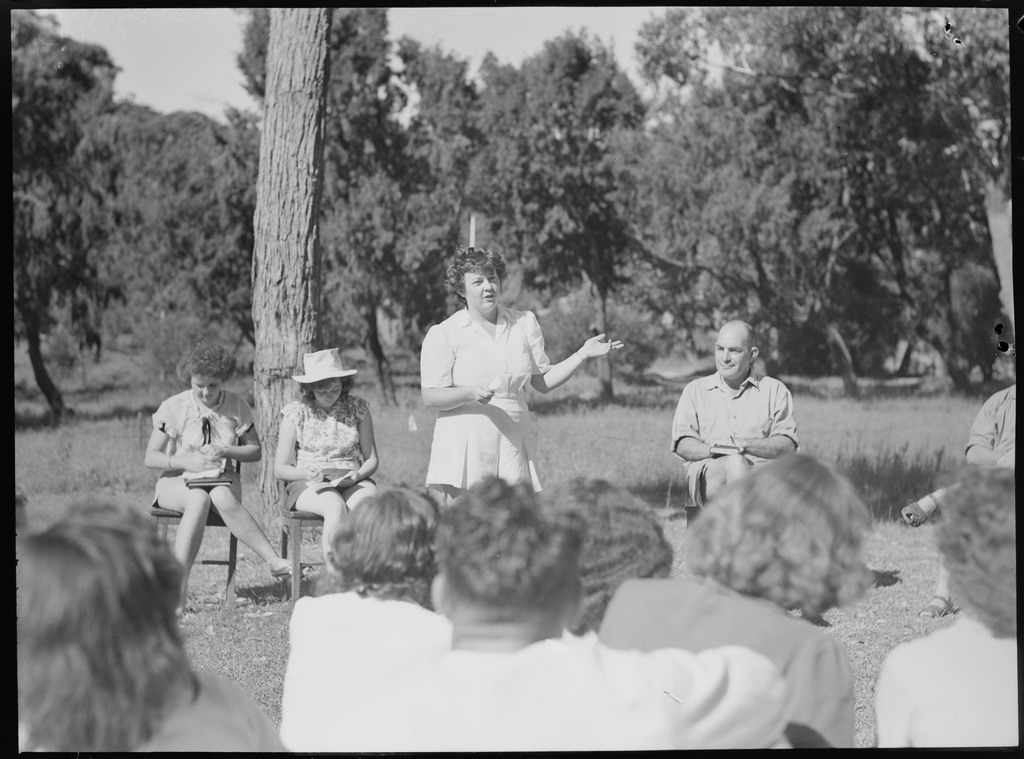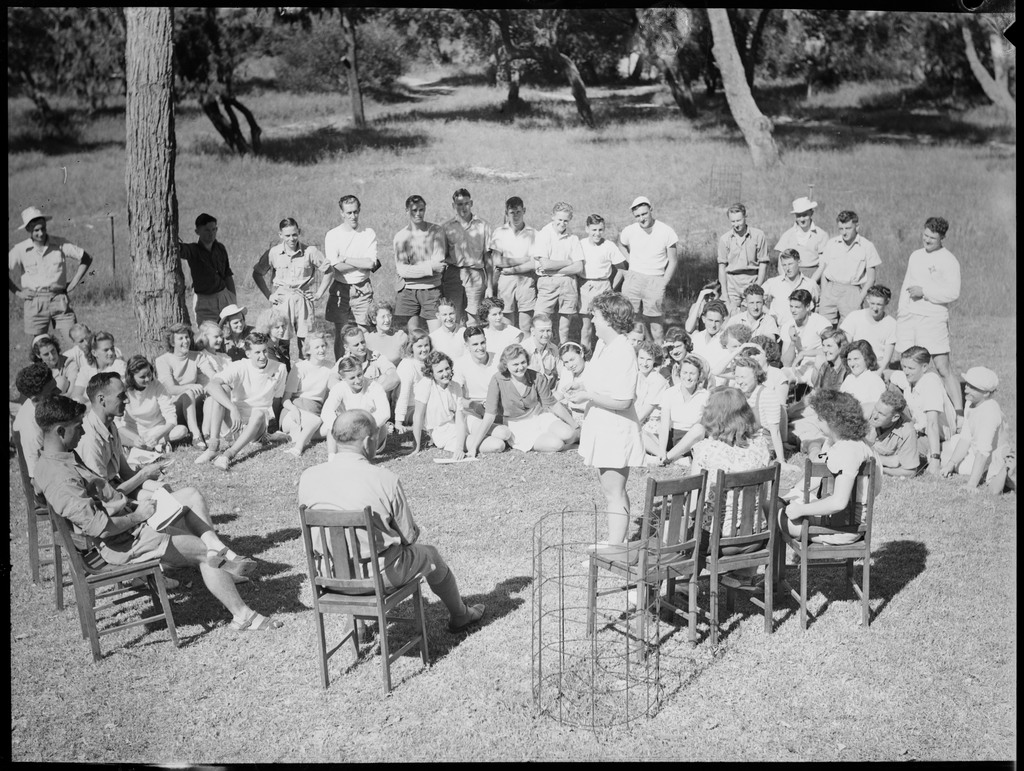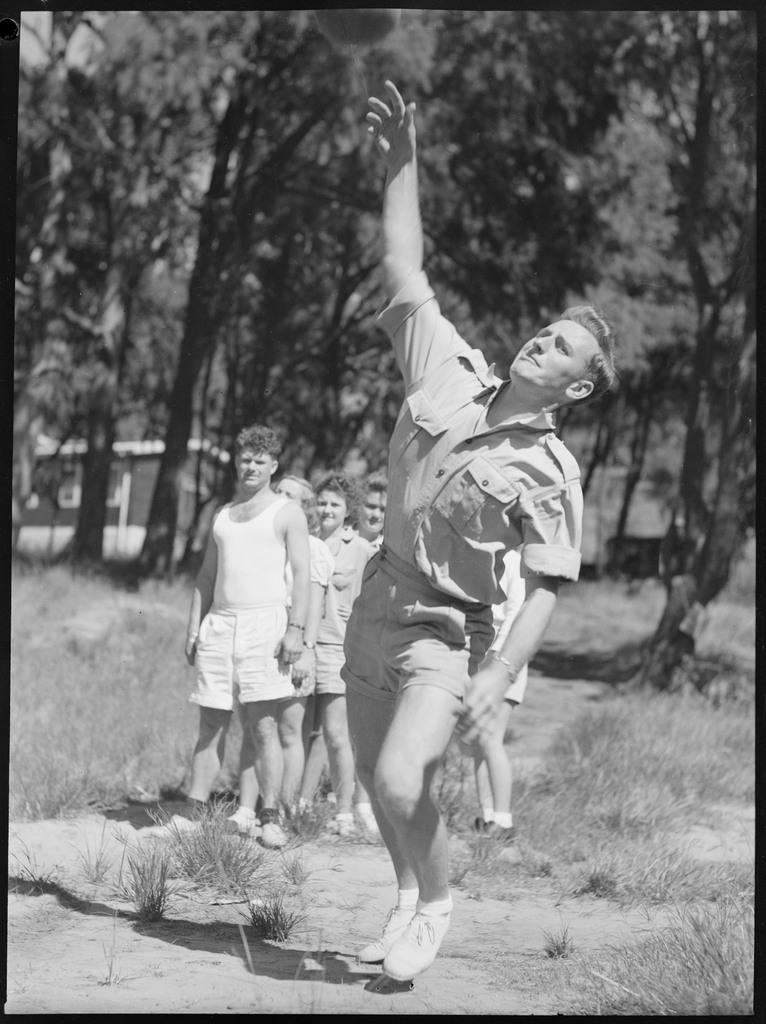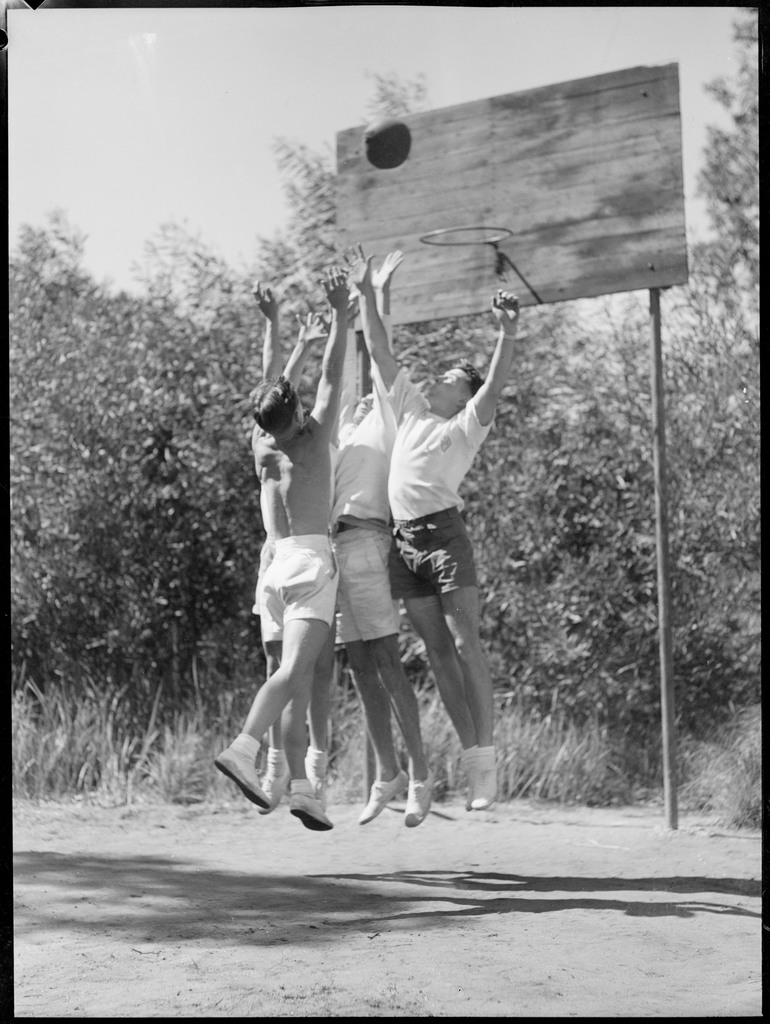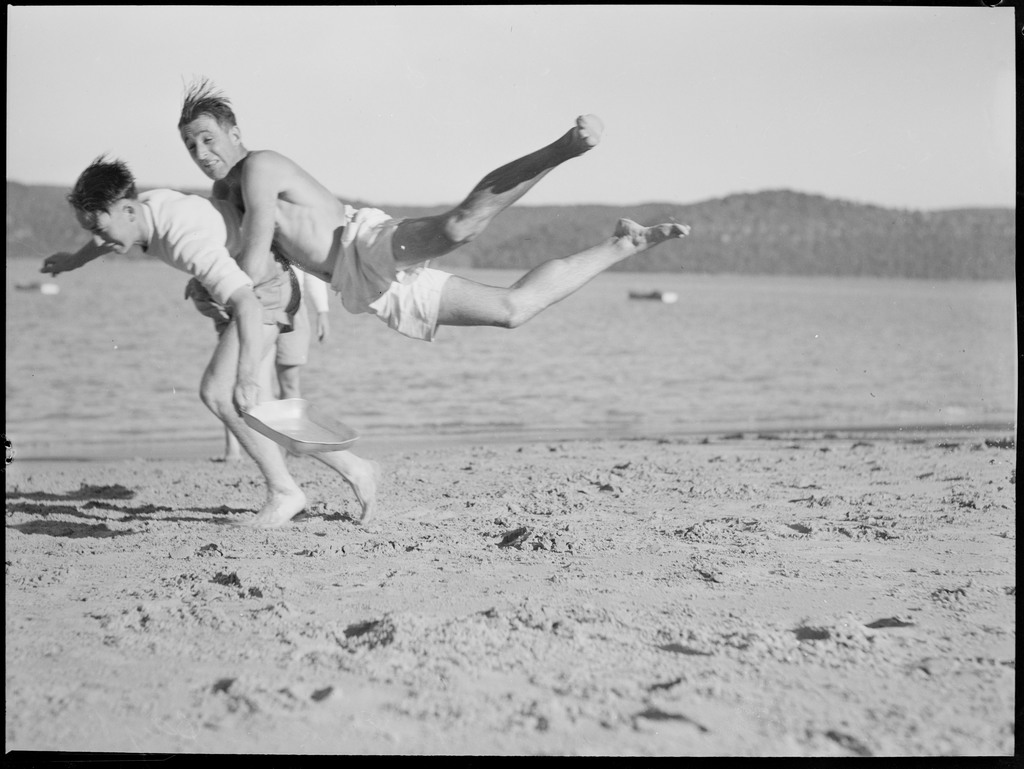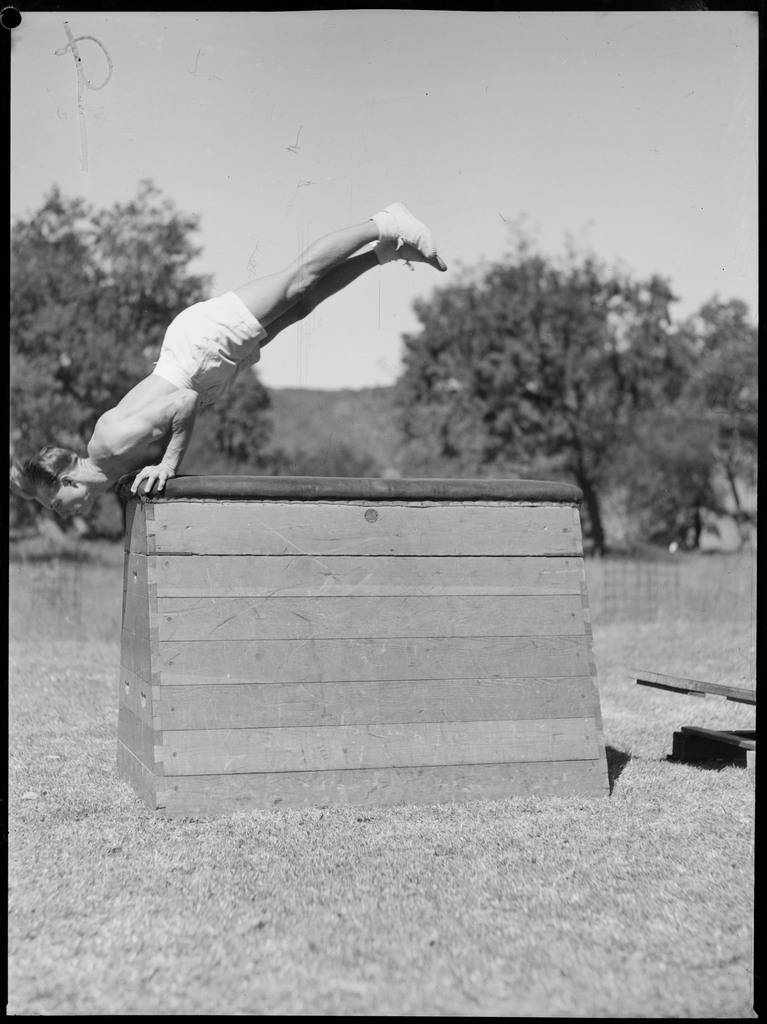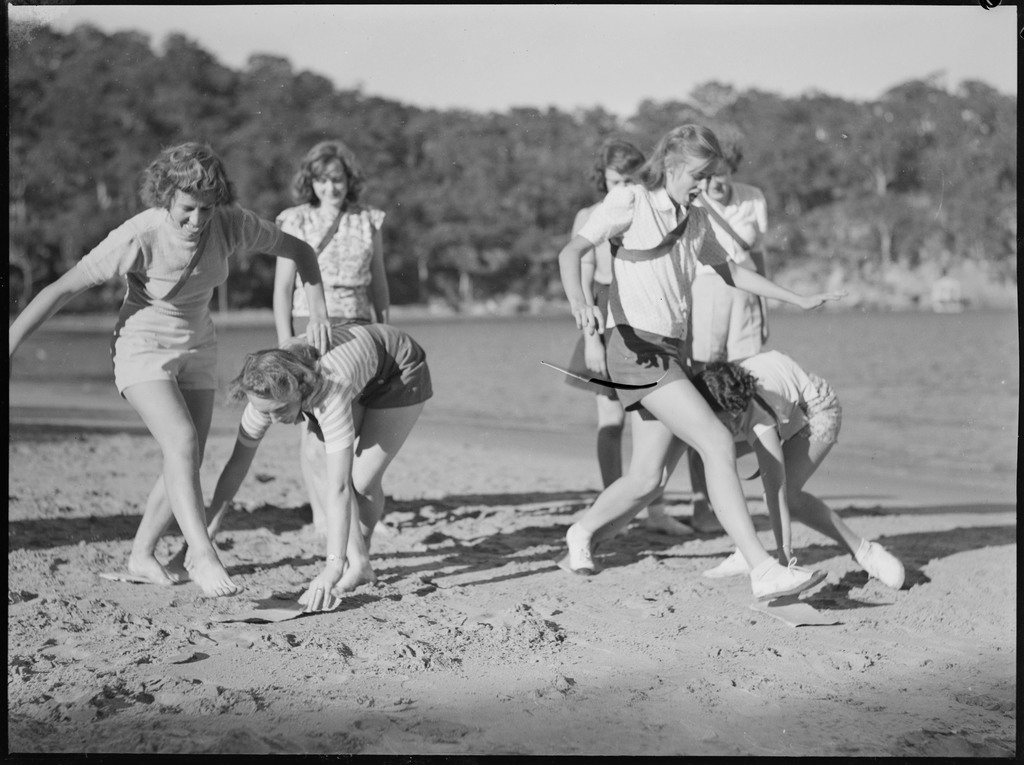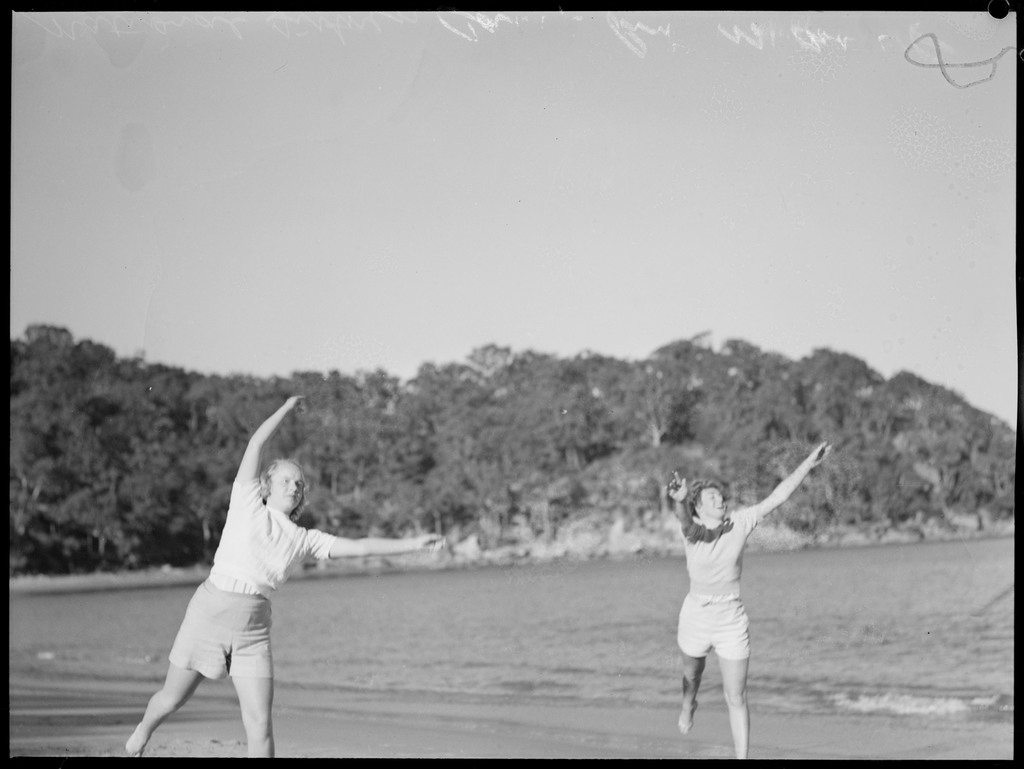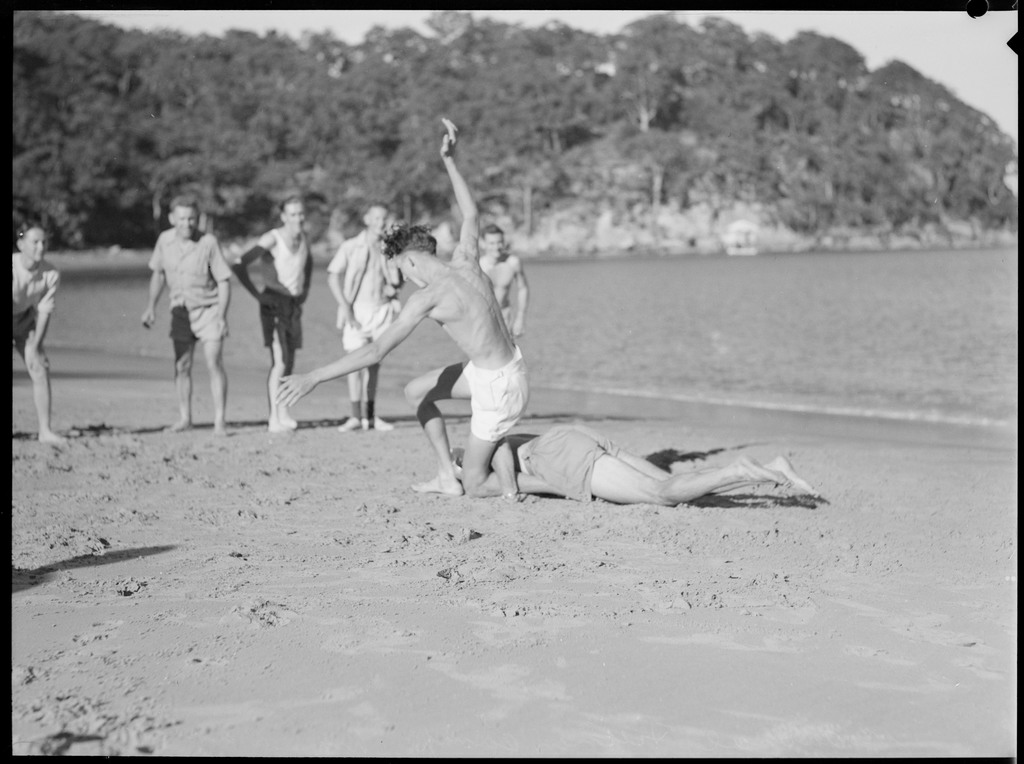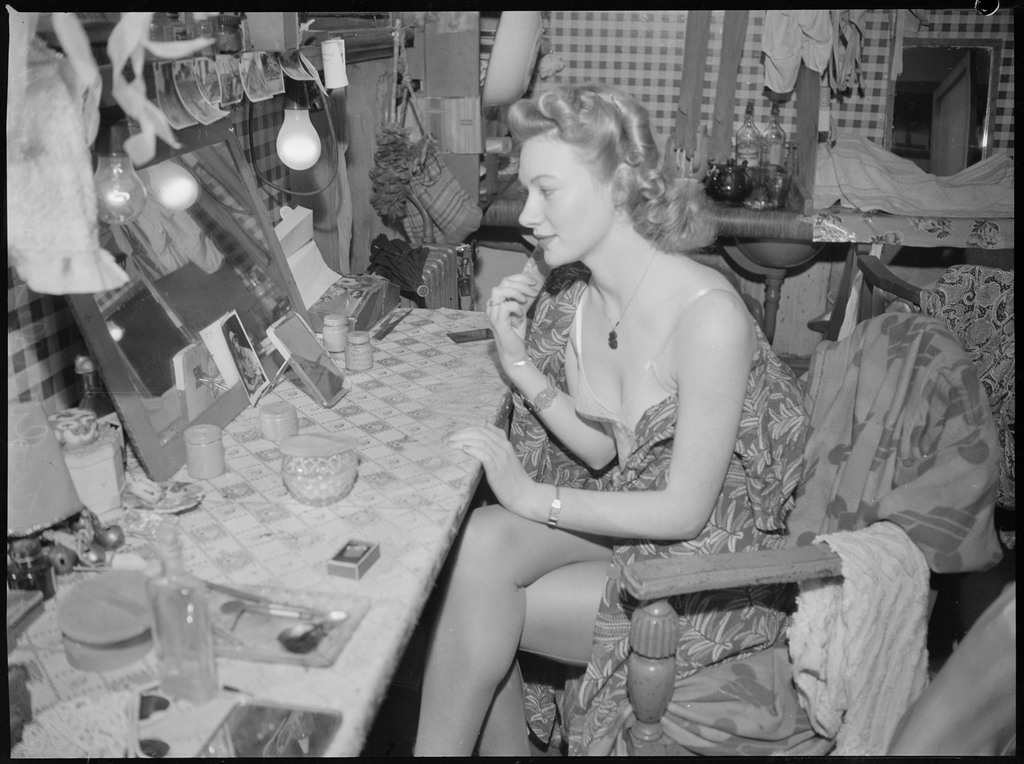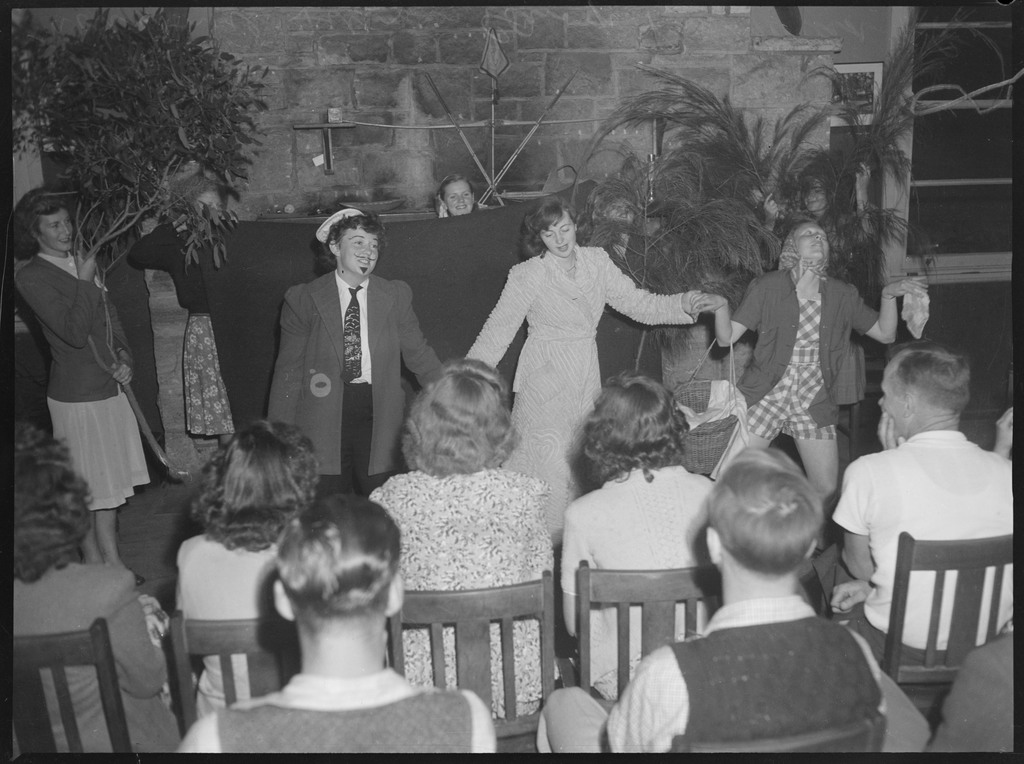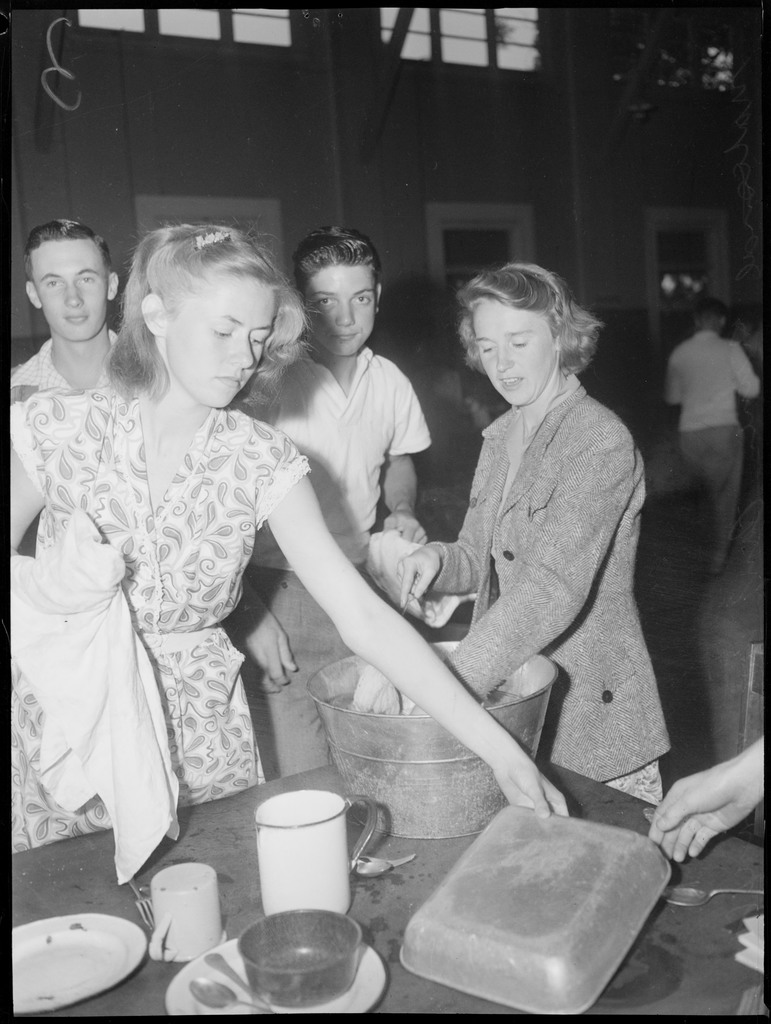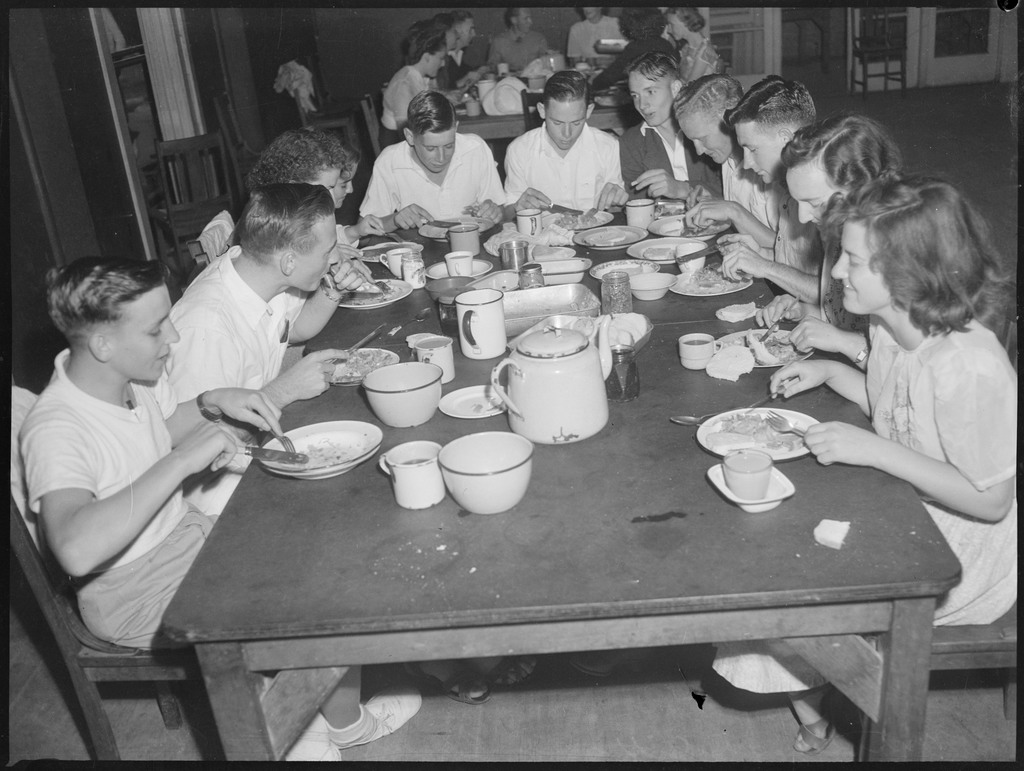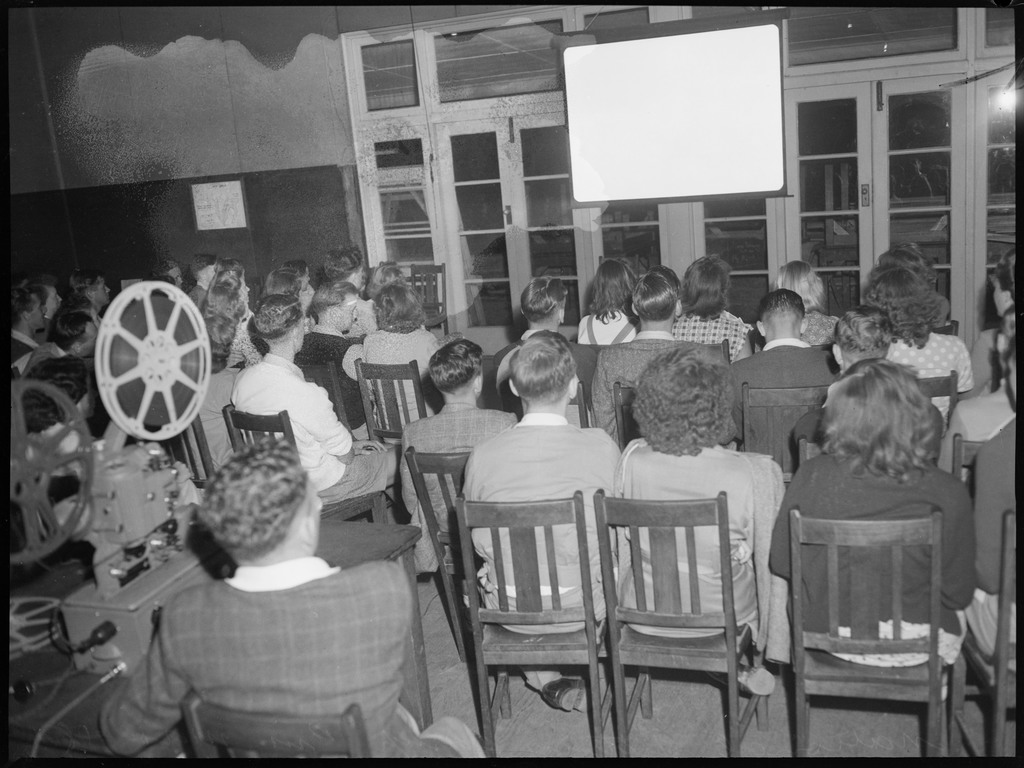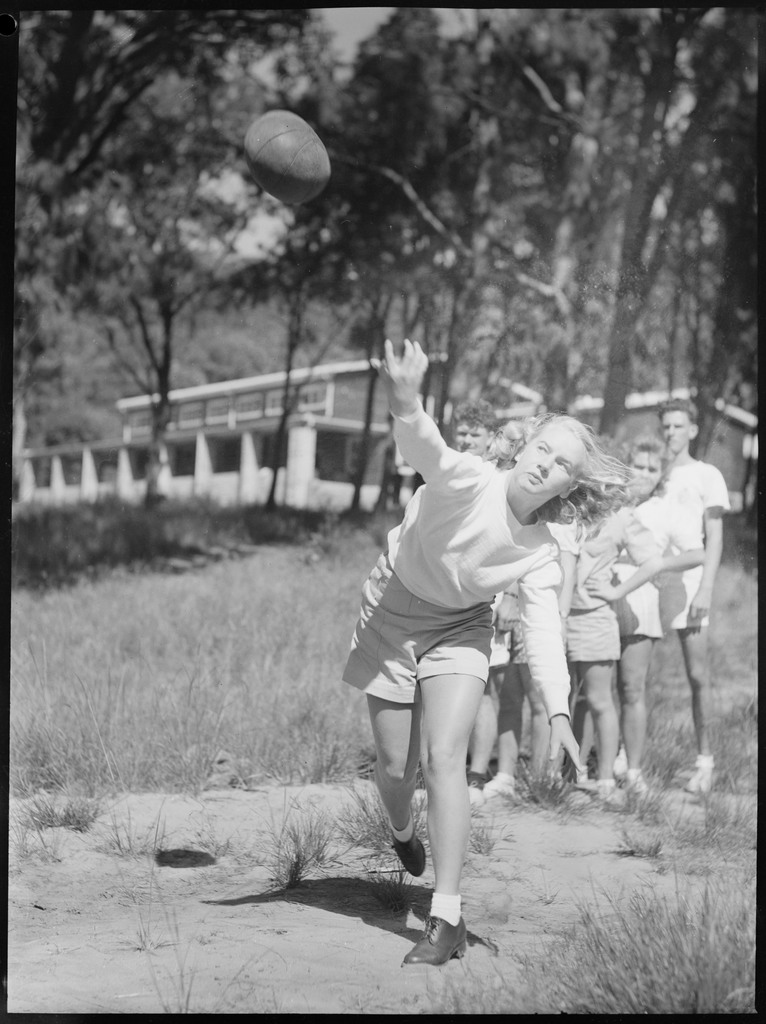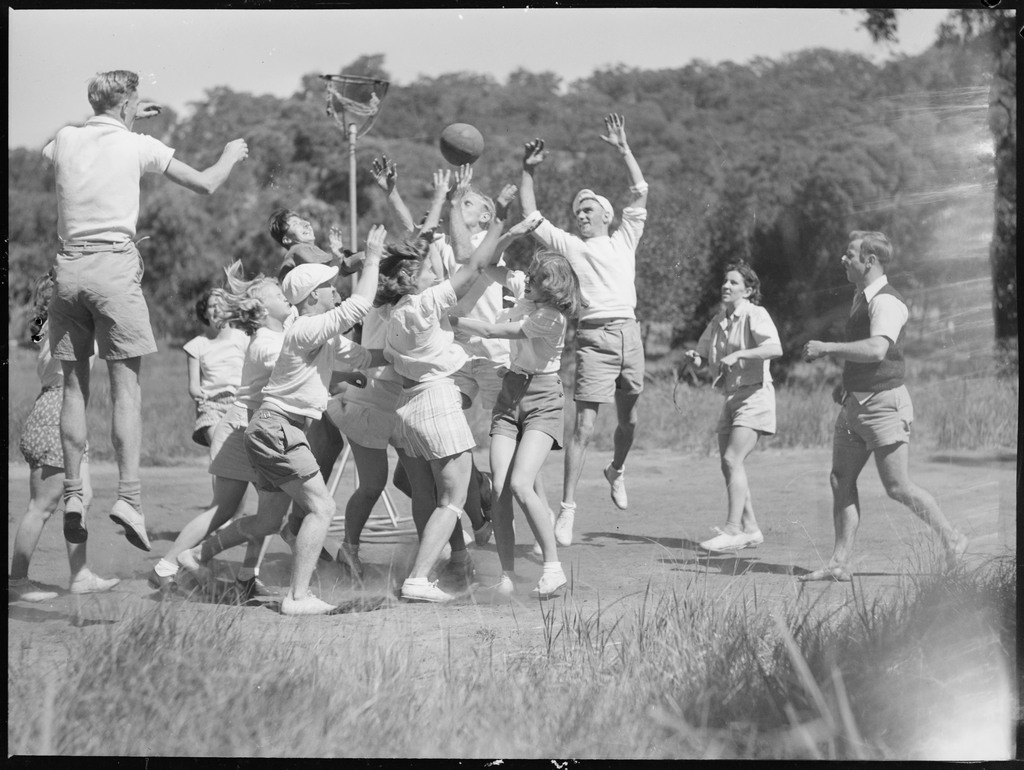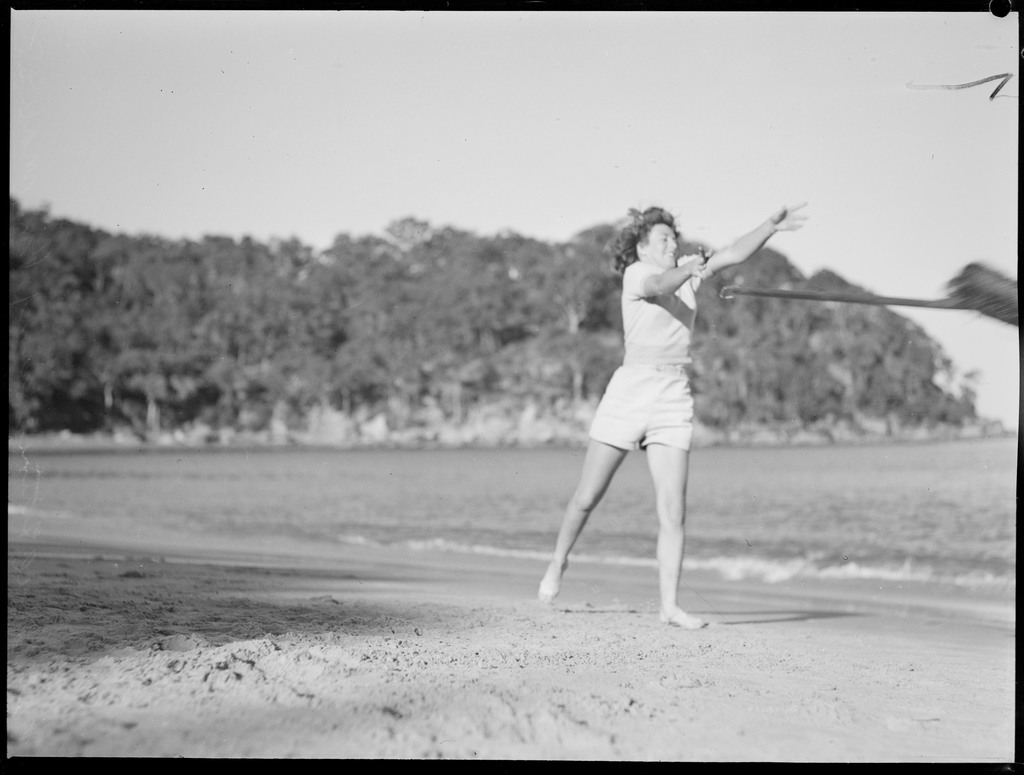National Fitness Centres at Broken Bay, Mona Vale, Narrabeen: Local History shows we like to move it! Move It!
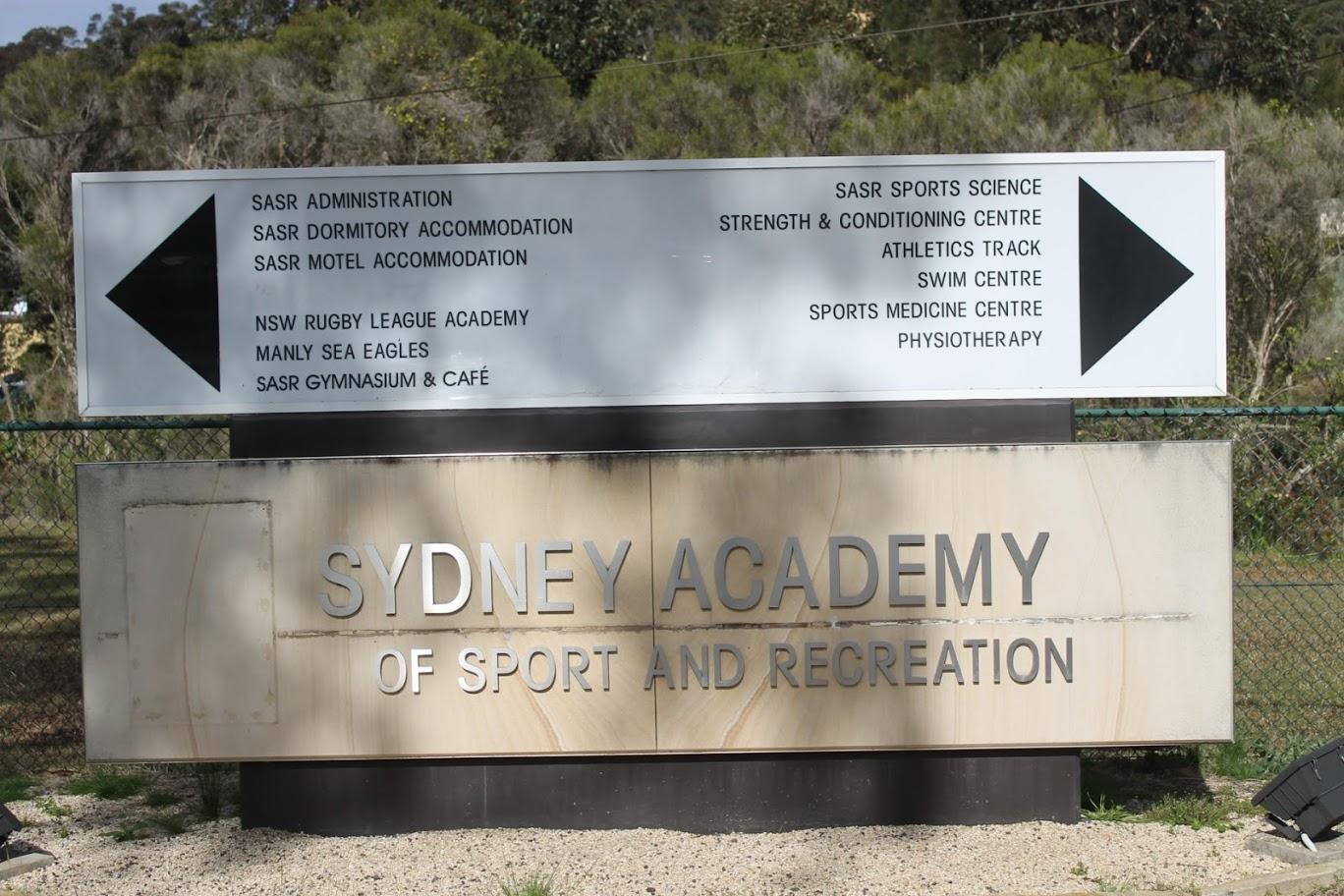
With the Winter School Holidays now here, a few insights into some local 'school camps' may be of interest to Readers aged 4 to 94. As so many have been dedicated to sport locally for so long as a necessity if rowing from one side of the estuary to the other to go fishing, or as a means to attract tourists through building amusement grounds, cricket pitches in paddocks and hosting visiting teams, cycling to Pittwater, sailing and rowing on the estuary, a proliferation of tennis courts, it should come as no surprise that Pittwater and the waters of Broken Bay became a focal point for ensuring everyone has room to move it as part of what we also learn in school.
Although local schools and local residents had recognised the need for sports for children as a means of play and a person's development, learning how the individual is part of a team and part of the society and community they are growing up into, in areas outside of Pittwater there had been little or no provision for playgrounds in inner city areas and no provision of teachers supervising 'play' in school playgrounds.
In a report made in 1870 by a Mr. J. McCredie, an Inspector of Schools, he stated:
"The personal supervision of the playground by the teacher still continues unsatisfactory in the majority of schools. Too often the teacher disappears when the pupils pass into the playground and does not re-appear until the time tor entering school again is close at hand. In the meantime the children are left to amuse and conduct themselves as they will and can; the teacher's opportunity of guiding them in their play, controlling their language and demeanour to each other, and observing the bent of each one's character, is lost and insofar as he has failed to do his duty. Thus his influence is lessened and the general tone of his school suffers from his own neglect.
By the early 1880s several public schools in Sydney were conducting after-school sport and teachers were meeting to arrange exchange visits between schools. Up the river:
SCHOOLS' DEMONSTRATION.
ON Monday last there was a meeting of the Committee who are arranging the Sports, &c., in connection with the Children's Gala Day, to take place on the 27th June, 1881, and open to all the children attending the Public and Denominational Schools in this district. The Mayor of Windsor occupied the Chair.
It was decided to hire the Hawkesbury Racecourse for the occasion ; but the proposition wats to lie over until the next meeting, for confirmation. ...SCHOOLS' DEMONSTRATION. (1881, May 28). The Australian, Windsor, Richmond, and Hawkesbury Advertiser (NSW : 1873 - 1899), p. 2. Retrieved from http://nla.gov.au/nla.news-article66358542
A Public Schools Amateur Athletic Association of New South Wales was being discussed and in 1885 the Association came into being. This was to have a profound effect on physical education in the schools and grew into the largest school sport association of its kind in the world. The games enjoyed by such large numbers of school children, produced sportsmen who achieved world recognition, prompting one Inspector to state:
"The P.S.A.A.A. encouraged the Australian love of sport and it helped to produce a race or people whose participation in sport is unequalled in any other country.''
The P.S.A.A.A. pointed a way toward the solution of a difficult problem and how to secure the wholehearted support of the teachers in a physical education programme and at the same time to secure the interest and enthusiasm or the pupils in their later community life. There were 'Gala Days' alike this one held at Clontarf:
JUNIOR TEACHERS' ATHLETIC CLUB SPORTS.
The second annual meeting of this association, took place at Clontarf on Saturday, and was a great improvement on that of last year. There was a very large attendance of junior teachers of both sexes, and among the visitors present were Messrs. E. Johnson, Under-Secretary of Public Instruction; C.T. Maynard, Chief Inspector ; J. Gardiner, Chief Examiner, A. L. Forbes, District inspectors J M'Intyre, J.H. Murray, John Wright, principal of the training school, Fort-street, A. Adams and Edmunds, assistant masters. Captain Mulholland, Mr. and Mrs. Doff, Mr. and Mrs. John Plummer, Bey. 'W. Bradley, &c.
The Minister of Public Instruction was to have attended, but his presence was required elsewhere. The sports committee consisted of the following gentlemen: — Captain Mulholland, and Messrs. J. Wright, A. Adams, Blumer, Berry, Webster, Fox, Black, Thackeray, and Laws. Captain Mulholland acted as starter. Referees : J. Wright and A. Adams. Judges: P. J. Edmunds, J. Conway, W. . Beavis, and W. Thomas. Judge of walking: W. C. Shipway. A. Adams, honorary treasurer. W. Laws, honorary secretary.
The programme was a good one, and the results were as follow- — 100 'Yards Pupil Teachers' Handicap— Simpson 1, Crimmings 2, Owen 3. Hop, Step, and Jump.— Walsh 1, 38ft 11in; E. Webster 2. 100 yards Students' Handicap.— A Roberts 1, Newton 2, Camplia 3. . One Mile Walking Handicap.— J. Thorn 1, TJ. Bulloct 2. Thorn disqualified for running. 150 Yards Champion Race. — A. Soherts 1, Campling and Cnmmings tied for second place. Three-quarter Mile Handicap.— A. Cousens 1, G. Smith. 2. 120 Yards Hurdle Race Handicap. — Walsh 1, Hewitt 2, Webster 3. The 100 yards Egg and Spoon Race was won by M. Eyan. F. W. Mannell won the 150 Tarde Ex-students' Handicap. The 220 yards Ladies' Bracelets (3) Handicap terminated as follows :— H. Hewitt 1, C. Thackeray 2, G. Smith 3. and A. Roberts. An interesting Tug of War, 20 students v. 25 pupil teachers, best two out of three, was won by the students, who pulled well together. The prizes, which are of a. very handsome character, will be presented on Saturday week. A band of music was in attendance, and dancing and other amusements were enjoyed during the whole day. Not a single mishap occurred to mar the pleasure of the holiday. JUNIOR TEACHERS' ATHLETIC CLUB SPORTS. (1885, September 15). Evening News (Sydney, NSW : 1869 - 1931), p. 6. Retrieved from http://nla.gov.au/nla.news-article111340071
And meetings to discuss the rules and how to grow the association:
Public Schools Athletic Association.
A meeting of teachers and officers under the Department of Public Instruction was held on Saturday at the Castlereagh-street Public School, for the purpose of passing rules and electing office bearers for the Public Schools Athletic Association. Mr. E. Johnson, under-secretary of the department, occupied the chair, there being a good attendance. The rules, which are 27 in number, were read by the acting- secretary, Mr. W. J. Rooney, and they were adopted. They provide that all persons connected with the department shall be eligible for membership; schools joining the association shall be registered; there shall be an annual sports meeting in the month of September; all competitors at sports meetings must be amateurs according to the customary definition of such, but nothing in the rule shall be urged as a bar against bona-fide school pupils who may compete for money prizes. The association shall be affiliated to the New South Wales Amateur Athletic Association. The following office-bearers were elected: — Patron, the Minister for Public Instruction ; president, Mr. E. Johnson, under-secretary for Public Instruction ; vice-presidents, Messrs. J. C. Maynard, F. Bridges, J. Conway, H. C. L. Anderson, M.A., J. M'Credie, Dr. Morris, and J. Dettman; secretary, Mr. W. J. Rooney: assistant secretary, Mr. W. F. M'Manany; treasurer, Mr. R. C. L. Anderson; committee, Messrs V. W. Mannell, E. Banks, G. Thornton, Captain W. P. Mulholland, J. V\r. Turner, H. Parkinson, and G. H. M'Phie; auditors, Messrs. J. K. Sirkoni and G. H. Huffer. A vote of thanks to the chairman then closed the meeting. Public Schools Athletic (1889, April 6). The Sydney Mail and New South Wales Advertiser (NSW : 1871 - 1912), p. 715. Retrieved from http://nla.gov.au/nla.news-article161931330
There was little provision for physical education or sports equipment unless that happened within the community of the school itself. The school in the old church at Chapel Point (Church Point) provides one example of this as soon after the school's opening, a way to raise funds for sports equipment is recorded:
CONCERT AT PITTWATER PUBLIC SCHOOL.
A concert took place in the Public school, Pittwater, on Saturday evening last, which was a great success in every way. The proceeds of the concert were to purchase a croquet set for the girls and a cricket set for the boys. The programme consisted of 30 items-songs, duets', recitations, readings, and instrumental music, all of which passed off most creditably.
Much valuable assistance was rendered by the following ladies and gentlemen of Sydney and the district:-Miss Buchanan, Miss Alice Chave, Miss Chave, Miss Elsie Chave, Miss Fahe, Miss Gracie Green, Mr. Aitken, Mr. Giles, Master A. Chave, Mr. F. Chave, Mr. F. Beverley, Master F. Faho, Mr. Cox, Mr. Scott, and others. The school children sang, with great gusto, "The harp that once," "A. B. C," "The Bay of Biscay," and "Home, Sweet Home."
The school was tastefully arranged with Chinese lanterns and lamps, and was well attended by the residents and well known gentlemen from Sydney. The concert terminated with the National Anthem shortly after 9 o'clock. CONCERT AT PITTWATER PUBLIC SCHOOL. (1888, June 19). The Sydney Morning Herald (NSW : 1842 - 1954), , p. 8. Retrieved from http://nla.gov.au/nla.news-article13689447
Later on:
BAY VIEW PUBLIC CENTRAL SCHOOL.
The report of Mr Lobban senior Inspector, was read at the annual distribution In connection with the Bay View Public central School. This showed that good work had been accomplished and reference was made to the satisfactory working of the school launch - the first experiment of the kind. Short addresses were delivered by Mrs F Anderson, Miss E Pye (Education Department Victoria) and the teacher. The prizes were presented by Mesdames Anderson and Taylor. The principal prize winners were - L Morrison H Newman H Howlett R Howlett J Morrison S Lloyd and M Booth. After refreshments various sports were indulged in. BAY VIEW PUBLIC CENTRAL SCHOOL. (1905, December 20). The Sydney Morning Herald (NSW : 1842 - 1954), , p. 12. Retrieved from http://nla.gov.au/nla.news-article14735150
Mrs F Anderson is Maybanke Anderson who was also behind the establishing of Kindergartens for children. On Thursday August 1st 1895 an event took place which would become part of what this lady was known for. Also present was the gentleman she would eventually marry and spend over two decades with - Professor Francis Anderson. Although they may have met when she was an office-holder for the 1891 formed Sydney University Women's Society, in the work of establishing free kindergartens their mutual ideals met. This article gives an insight into what many pupils of Maybanke described afterwards as a 'child focused' education:
KINDERGARTEN UNION.
A demonstration of kindergarten methods was held at the Congregational Hall, Pitt-street, yesterday afternoon. The chair was taken by Dr. Sydney Jones, and there was a good attendance of ladies and gentlemen interested in this system of education. The children came from the Wesleyan College at Burwood, being in charge of Miss Scheer, whilst others were from the Girls' College at North Shore, and in charge of Miss Liggins and Miss Arnold.
The Chairman, in opening the proceedings, said that he had no knowledge of the practical work of the system, but he knew something of its principles and of the advantage which it was in the harmonious development of the physical, mental, and moral powers of children.
Professor Anderson gave a short address, in which he pointed out the advantages of the system, one special feature being that, whilst the ordinary methods of teaching were repulsive to children, the kindergarten plan was interesting to them.
During the course of the proceedings an address was given by Mrs Wolstenholme, in which she explained that the demonstration was under the auspices of the Kindergarten Union. She spoke of the object and the methods of the system. The committee of the union, she stated, were of opinion that the educational system adopted in schools all the world over did not do all that was necessary to develop the powers of the children. In New South Wales the kindergarten system had been misunderstood. It had suffered from being adopted hastily, and from having been carried out mechanically, and without the spirit which should vitalise it in our schools.
One object of the union was to acquaint parents with the system. Usually children were brought up to pass an examination, and their cleverness was measured by the manner in which they reached a certain standard. This plan was faulty, inasmuch as it did not do the utmost to develop the powers of the children.
The union was in favour of having free kindergarten schools established here after the plan adopted in America. Even in New South Wales too many children were left to roam about the streets. That developed the worst side of them the kindergarten school, on the contrary, would develop the best side of them. It was thought that the Government should lend its aid in this matter. It was also thought that a training home for girls should be established. Here girls could be taught the care of children and the best meant of attending on them. We all admired the advance which was being made in sick-nursing at the present day. Everyone respected the nurses who now wore uniforms, and who had altogether superseded Mrs Gamp. It was not meant that the kindergarten school should teach sick-nursing, but it was thought that there would be a great advantage in having girls properly trained to the responsibilities of the nursery.
During the afternoon the children gave an exposition of the system, under the directions of Miss Scheer and Miss Brown. The lessons were followed by games, and the proceedings generally were of an interesting character. Votes of thanks were passed to the chairman and to the ladies and gentlemen who were connected with the demonstration. KINDERGARTEN UNION. (1895, August 2). The Sydney Morning Herald (NSW : 1842 - 1954), p. 3. Retrieved from http://nla.gov.au/nla.news-article13991443
In 1897 the Department acknowledged the voluntary service provided by the teachers in their after-school hours, and school sport was incorporated in the school programme in school time.
On the other side of the estuary Pittwater has another claim to early shifts towards ensuring people have access to green open space and movement therein. The vision to create a place that took into account having open green spaces, making the most of an environment and ensuring places to play remained part of a community was an ethos Arthur Jabez Small, developer of Avalon Golf Course and originator of the name for 'Avalon Beach' followed and which that led to the formation of the Parks and Playgrounds Movement:
Urged on by its citizens for years, in 1937 the Department of Public Instruction decided to proceed with the organisation of physical education on a state-wide basis, as greater recognition was being given “to the national importance of a high standard of physical fitness among peoples, and measures for promoting the standard of physical education are being taken by every progressive country…The Department aims at bringing school physical education activities into harmony with those of outside organisations.”
PHYSICAL EDUCATION.
Training in Leadership.
Many speakers extolled the objects of the Leadership Training College of Physical Education and Recreation, which held its first meeting in the Education Building last night.
The Minister for Education (Mr. Drummond) said there was room in New South Wales for such a college to serve the changing times in a useful and valuable way. There was wide scope for physical education and recreation leadership, and he wished it success.
Dr. C. E. W. Bean said physical deterioration was due not only to overcrowding, or inferior diet, but to deprivation of natural exercise for both, body and mind.
Dr. Harvey Sutton said that at an examination of 1500 recruits for the police force, over a number of years, only 23 per cent. were accepted. After treatment that number was increased to 35 per cent.
Dr. A. H. Martin said there was justifiable criticism of sports masters of secondary schools. For the most part, they were chosen because they excelled in sports. Many of them were merely coaches. PHYSICAL EDUCATION. (1937, July 13). The Sydney Morning Herald (NSW : 1842 - 1954), p. 12. Retrieved from http://nla.gov.au/nla.news-article17372614
NEW PHYSICAL EDUCATION POST
The Premier (Mr. Stevens) said yesterday that it was proposed to appoint a special director of physical education. "His principal duty will be to organise a teaching service that will give general physical education, adapted to the needs of each child. "I would like to see it develop into physical training for children who have left' school, and even adults," said Mr. Stevens. The Government had allotted £10,000 for improved physical education of school children. Mr. Stevens laid the foundation stone of a new ice-cream factory for the Fresh Food and Ice Co., Ltd., in Harbor Street. NEW PHYSICAL EDUCATION POST (1937, November 3). The Daily Telegraph (Sydney, NSW : 1931 - 1954), p. 10. Retrieved from http://nla.gov.au/nla.news-article247329648
PHYSICAL EDUCATION SCHEME
Applications for the position of State Director of Physical Education are to be called by the Government, and it is likely that the position will be filled from abroad. Designed to Improve the health standard of the children of the State, a scheme submitted to the Government months ago by an outside physical culture expert is at last to be put into operation. The children will be classified according to age and physical capacity, with special attention being giver, to this suffering from inadequate chest development and other defects, and provision will be made for the training of teachers in physical culture instruction. The Minister for Education, Mr-Drummond, said last night he had approved, as part of the physical education and recreation policy, of school buildings and playgrounds being made available to Parents and Citizens' Associations during vacations. PHYSICAL EDUCATION SCHEME (1937, November 16). The Labor Daily (Sydney, NSW : 1924 - 1938), p. 4. Retrieved from http://nla.gov.au/nla.news-article237755981
A Physical Education Advisory Committee was set up, complete with sub-committees and advisory groups, in order to make recommendations to the Minister. The State Council for Physical Fitness was then constituted in 1939, replacing the earlier Advisory Committee. The Council’s function was to promote physical fitness in the general community and advise the Education Department on physical education in schools. In 1938, a Director of Physical Education was appointed and in 1939 the Department of Public Instruction established the National Fitness and Physical Education Branch (also known simply as the Physical Education Branch). A few insights from the newspapers of the past:
YOUTH TRAINING. PHYSICAL EDUCATION. ADVISORY COMMITTEE APPOINTED.
The Premier (Mr. Stevens) announced last night that an Advisory Committee had been appointed to assist the Government in its proposals for the development of a scheme of physical education and youth training. The Government has for some time been considering a plan for the organisation of physical training on a scientific basis, following the example set by other countries.
The personnel of the committee will be as follows:-Mr. George Martin (chairman), Professor Harvey Sutton, Dr. C. E. W. Bean, Mr. L. C. Robson. Dr. H. G. Wallace, the Very Rev. John S. Meagher, Di. A. E. Machin, Mr. Stephen Lynch, Miss E. M. Lewis, and Mrs. F. J. Davy.
The Premier stated that this committee. Which would begin work immediately, would undertake all the preliminary steps for the development of the scheme, and would advise the Government generally until an Advisory Council with statutory functions was established.
Mr. G. Martin is Staff Inspector, assisting the Assistant Under-Secretary of Education and superintendent of Technical Education, and Is an officer of wide experience.
Professor Harvey Sutton is a Rhodes scholar, was formerly principal medical officer of the Department of Education, and is now director of the University School of Health and Tropical Medicine, and president of the Board of Social Study and Training.
Dr. Bean is well known for his work for the Parks and Playgrounds Movement.
Mr. Robson is a Rhodes scholar, a representative of the private secondary schools on the Board of Secondary School Studies, and a member of the Advisory Council of Education.
Dr. Wallace is the senior medical officer. Department of Health.
The Very Rev, J. S. Meagher, head of St. Ignatius' College, Riverview, is recognised as an outstanding authority on youth training.
Dr. A. E. Machin is the principal medical officer of the health branch of the Department of Education.
Mr. Stephen Lynch has been for many years the organising secretary of the Public Schools' Amateur Athletic Association.
Miss E.'M. Lewis is noted for her association with the Recreation and Leadership Movement, of which she is vice-president.
Mrs. F. J. Davy has been for many years a recognised leader of organised sport for young women, and an advisory member of the physical education and sports section of the Y.W.C.A. She is vice-president of the N.S.W. Amateur Sports Council, and is associated in an executive capacity with the National Council of Women. Until recently she was an executive, member of the Sydney Day Nurseries Association. YOUTH TRAINING. (1937, December 21). The Sydney Morning Herald (NSW : 1842 - 1954), p. 11. Retrieved from http://nla.gov.au/nla.news-article17425295
Y.M.C.A. MAN FOR STATE POST
Mr. Gordon Young, of Montreal, has been appointed Director of Physical Education in New South Wales. This Cabinet decision was announced by the Minister for Education (Mr. Drummond) yesterday. Mr. Young, who is 32, will receive £950 a year. He will probably , take up duty about the middle of December. Director At Montreal Mr. Young is Director of Physical Education of the Central Y.M.C.A., Montreal. in 1927 he graduated from the International Y.M.C.A. College of Springfield, Mass., as a B.Sc., physical education, With credit. He is also a B.A. of the Western University, Ontario, and holds the American Red Cross certificate and the Royal Life Saving medallion. He has held a number of administrative positions in amateur sport in Canada. Y.M.C.A. MAN FOR STATE POST (1938, September 24). The Daily Telegraph (Sydney, NSW : 1931 - 1954), p. 5. Retrieved from http://nla.gov.au/nla.news-article247355691
NATIONAL FITNESS
Voluntary Campaign
CANBERRA, Wednesday. — A campaign for national fitness, organised on a voluntary basis, but , with, national direction, Is expected to result from the close Interest of the Federal Government in the New South Wales Health Week, according to a statement issued by the Australian Country party today.. The scheme, which . has been forcefully urged by "The Age," will be discussed at a meeting of the National Health and Metrical Research Council In Canberra on November 15. .The statement points out that the Federal Minister of Health (Sir , Earle Page) would have had a natural interest in the annual health demonstration, but to inaugurate the function it was more as Deputy Prime Minister and chief sponsor of the long-range plan for national defence and development that he visited Sydney. Sir Earle Page in his speech at Sydney proclaimed the health and nutrition of the people to be the first aim or all Governments, which, if recognised as such, would "push war right into the background." NATIONAL FITNESS (1938, November 3). The Age (Melbourne, Vic. : 1854 - 1954), p. 10. Retrieved from http://nla.gov.au/nla.news-article205201688
PHYSICAL FITNESS.
National Council to be Formed.
CANBERRA, Nov. 24;-After considering the resolutions passed at the recent National Health Council relating to physical fitness, the Federal Government has decided to form immediately a National Co-ordinating Council for Physical Fitness under the Minister for Health (Senator Foll) and to invite State Governments to co-operate by forming related State councils. Announcing this decision tonight, senator Foll said that the Government had also decided to convene an initial conference as soon as possible to discuss this question fully. Meanwhile the Government would make available for general distribution a memorandum recently prepared by Dr. E. S. Morris (Chief Medical Officer of New South Wales). "The whole question of the physical fitness of the nation requires a co-ordinated long-range policy," added Senator Foll. "and I am confident that much can be accomplished now that the Government is giving the people a lead." PHYSICAL FITNESS. (1938, November 25). The West Australian (Perth, WA : 1879 - 1954), p. 26. Retrieved from http://nla.gov.au/nla.news-article46496011
FALLACIES ABOUT PHYSIQUE
"There has been a lot of confused thinking about physical education, and it is time we clarified the issues." the recently-appointed Director oi Physical Education, Mr. Gordon Young, told the Recreation and Leadership Movement to-day.
He quoted a remark made to him at Bondi yesterday that "our young people won't go for this physical jerks stuff." Mr. Young said his policy would have three bases, first, grace of body and a physique capable of enjoying life; second, cultivation of contented mental attitude; and third, awareness of social responsibilities.
Professor Harvey Sutton said that Australians probably spent more per head on patent medicines than any other group of people. The Minister for Education (Mi Drummond) welcomed Mr. Young on behalf of the movement.
Debt To Sport
At a reception given to Mr. and Mrs. Young by the Physical Education Advisory Committee at the Australia Hotel, Mr. H. Heydon, of the N.S.W. Cricket Association, said that Australians owed their wonderful physical development to sport. Dr. G. M. Barron said that Australians should be made physically and mentally, an A1 nation. FALLACIES ABOUT PHYSIQUE (1938, December 19). The Sun (Sydney, NSW : 1910 - 1954), p. 3 (LATE FINAL EXTRA). Retrieved from http://nla.gov.au/nla.news-article231132045
PHYSICAL TRAINING.
Camp for Teachers.
More than 150 teachers have enrolled in the physical education camp, to be held at Brookvale in January by the Department of Education. The Director of Physical Education, Mr. Gordon Young, will reside at the camp for the ten-day period over which it will be held.
Most of the teachers enrolled are from country schools, and all are anxious to leam as much as possible about up-to-date methods of physical education. Each day will Include swimming and life-saving instruction, physical training exercises, methods and lectures, squad drill, organised games and athletic sport.
The Minister for Education, Mr. Drummond, said yesterday that camp schools would probably play an important part in future physical education activities, and that the school about to be held should prove a most valuable experiment. PHYSICAL TRAINING. (1938, December 30). The Sydney Morning Herald (NSW : 1842 - 1954), p. 9. Retrieved from http://nla.gov.au/nla.news-article17559024
NATIONAL FITNESS.
Mrs. F. J. Davy Appointed to Council.
The Minister for Health and Repatriation, Senator H. S. Foll, announced yesterday that he had Invited Mrs. F. J. Davy, of Sydney, to become a member of the National Co-ordinating Council for Physical Fitness. Mrs. Davy is a foundation member of the New South Wales Government, Physical Education Advisory Committee, formed by the Minister for Education, Mr. Drummond, in November 1937.
Her appointment will meet with wide approval from all women's sporting organisations. Mrs Davy has been honorary secretary of the New South Wales and Australian Women's Hockey Associations since 1921. She has travelled extensively with hockey teams, an has had every advantage of studying physical education problems in both England and the United States. Mrs. Davy is a vice-president of the New South Wales Women's Amateur Sports Council; is a director of the Rachel Forster Hospital for Women; a director of the Sydney Y.W.C.A.; a vice-president of the Parks and Playgrounds Movement; and an executive member of the National Council for Women, and of the Day Nurseries Association.
Mrs. Davy thus becomes the third woman member of the Federal committee, Mrs. Clarence Weber, M.L.A., of Victoria, and Mrs. Waterworth, of Tasmania, being the others. In the New Year's honours list In 1938 Mrs. I Davy was made an M.B.E. In recognition of her work for charitable organisations and for her Interests in women's sport. NATIONAL FITNESS. (1939, March 18). The Sydney Morning Herald (NSW : 1842 - 1954), p. 17. Retrieved from http://nla.gov.au/nla.news-article17574914
Throughout 1939, physical education within public schools was expanded and extended to embrace sections of the general community. As a result, the National Fitness and Physical Education Branch was responsible for physical education within schools and for physical fitness outside the schools. The responsibilities of the Physical Education and National Fitness Branch were the supervision of physical education throughout schools, conducting weekly and vacation swimming schools, the organisation of training courses in Physical Education, and liaison with the school cadet corps.
The Branch was also responsible for National Fitness Camps located (in 1939) at Broken Bay, Commodore Heights (Pittwater), Lennox Head, Midway Cabins (Hawkesbury River), Mona Vale at 'La Corniche' (1943) and soon after at Narrabeen Lagoon (1944), and Myuna Bay and Point Wolstoncroft at Lake Macquarie. The camps were maintained for school and vacation camping, training camps and as recreational and training centres for sporting and youth organisations. Programmes provide instruction in recreational activities, swimming, field-work, bushcraft, craft work, and social education.
As can be read above, William Gordon Young was appointed director of physical education within the Department of Education in New South Wales in 1938 and held his first camp to educate the educators at Brookvale in January 1939. The next year he also became the executive officer of the National Fitness Council of New South Wales. As a member (vice-president 1960) of the Rotary Club of Sydney, he persuaded it to build nine huts to sleep 180 campers at the State's first national fitness camp, at Broken Bay. Broken Bay National Fitness Camp is situated south of Little Wobby, close to Middle Bank. Gordon Young had also had a bit of a career in flying in the 1930's before coming to America and is recorded as having taken part in some air races in America - experience that stood him in good stead to get the foundations in for the first Fitness Camp in NSW. From a November 1940 magazine:
FIRST NATIONAL FITNESS CAMP
by K. Commins
The director of Physical Education in New South Wales, Mr. Gordon Young, has established the first National fitness camp at Patonga, Broken Bay, Sydney. During the last twelve months he has persuaded an enthusiastic band of young men to accompany him to Patonga each week-end to clear acres of land, quarry stone, build sleeping loges and do hundreds of other laborious tasks—and still they come back for more! Admittedly the Director is a man of personality and persuasive manner, but it needs something more than personality to induce volunteers, who slave at city desks all the week, to give their week ends to build a camp in every sort of weather. That something more has been leadership, and it is Mr. Youngs leadership which has made the National Fitness campaign into a working scheme.
His task has not been easy. There was no money to develop all the ideas necessary to make Australia a first class nation in health. To implement any of his schemes he needed a camp. He went searching, and along the quiet reaches of Broken Bay, in the wooded hills of tall trees ranging down to the sea with a beach and rough jetty at hand. Mr. Young saw in Patonga the ideal spot for the first of the National Fitness Camps. In February of this year the Lands Department gave the necessary permission for occupancy and Mr. Young and his army of volunteers got to work with materials supplied by the National Fitness Council and the Education Department.
Comparing Patonga with camps be has seen overseas Mr. Young has some very illuminating remarks to make.
“The National Fitness camp on Broken Bay is within forty miles of Sydney and offers advantages which can only be secured by great distances abroad. It provides climatic conditions which permit all the year round camps under ideal conditions. Moreover there is a variety of water sports, recreation games, biking and hill climbing seldom found in one site. I believe that Patonga promises to be one of the outstanding health camps yet established anywhere.
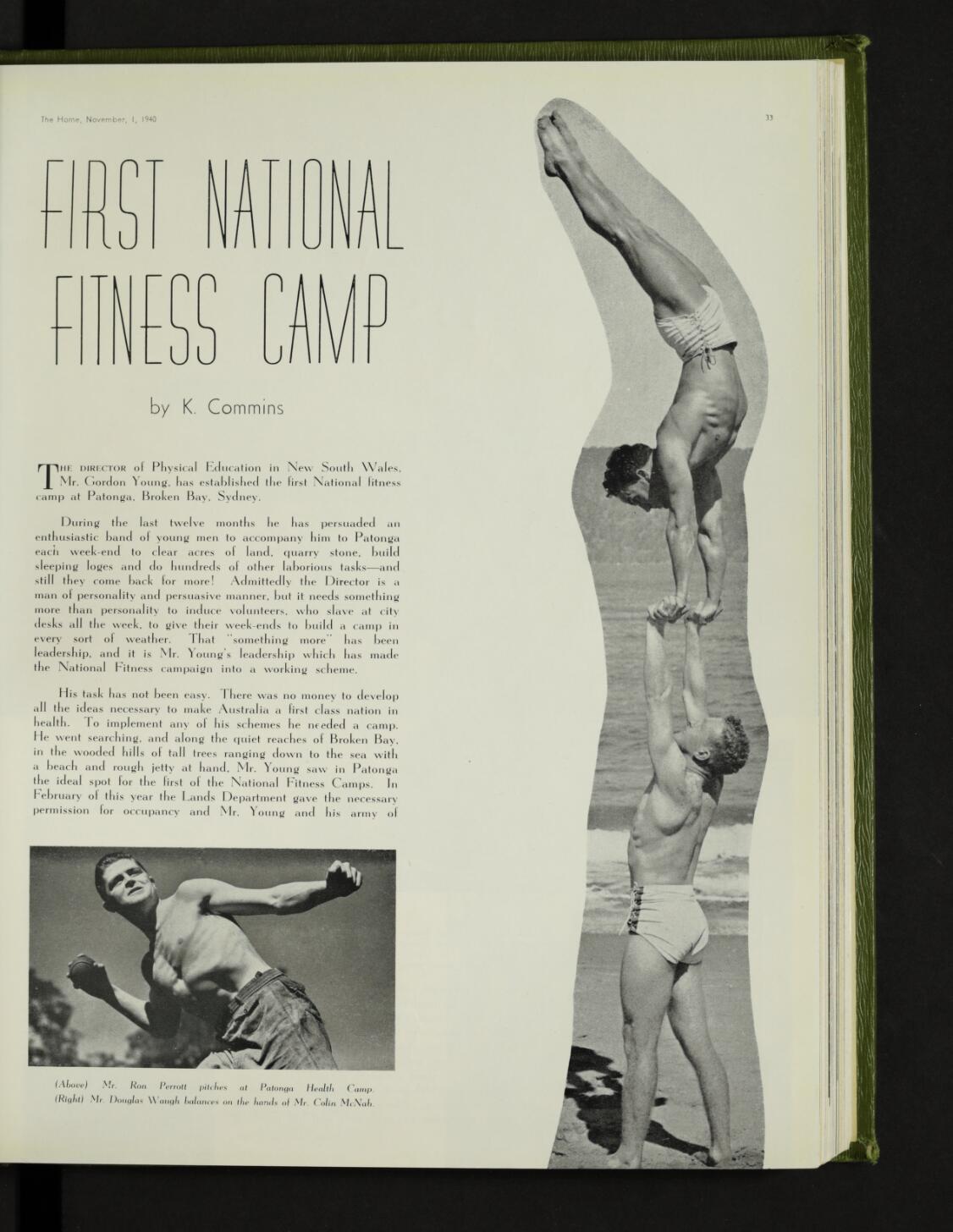
(Above) Mr. Ron Permit pitches at Patonga Health Camp. (Right) Mr. Douglas Waugh balances on the hands of Mr. Colin McNab. N. BROWN
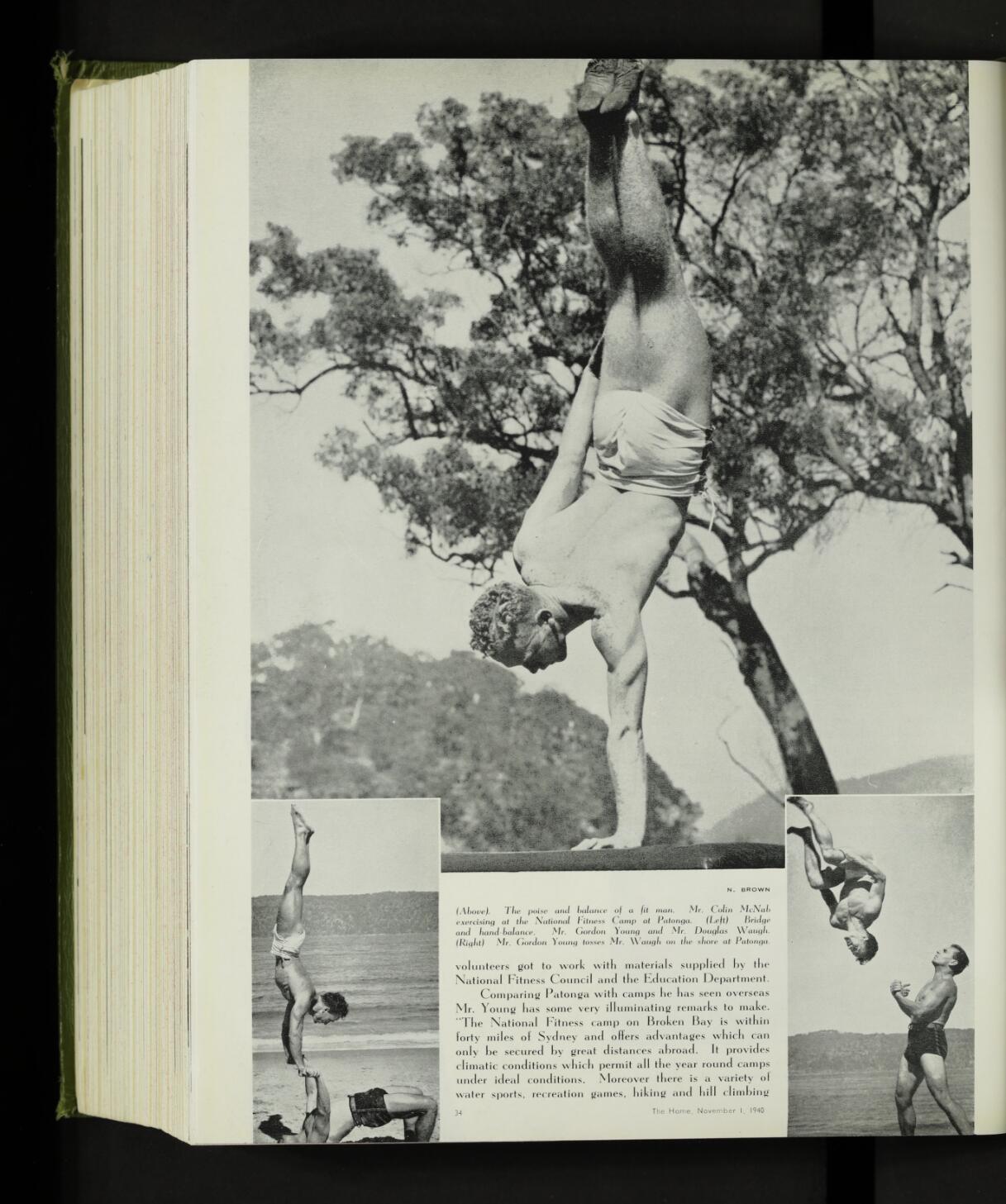
(Above). The poise and balance of a fit man. Mr. Colin McNab exercising at the National Fitness Camp at Patonga. (Left) Bridge and hand balance. Mr. Gordon Young and Mr. Douglas Waugh. (Right) Mr. Gordon Young tosses Mr. Waugh on the shore at Patonga. N. BROWN
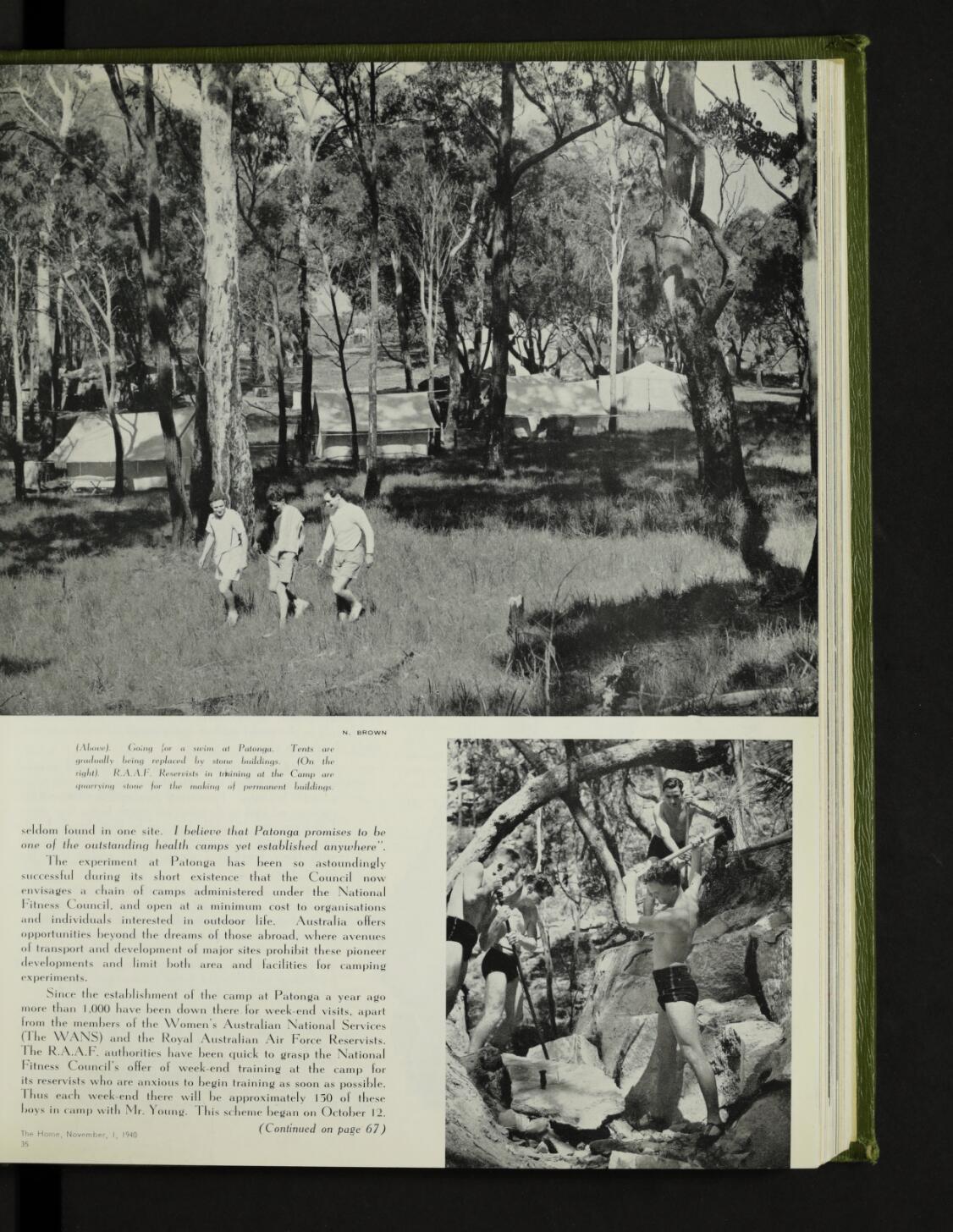
(Above). Going for a swim at Patonga. Tents are gradually being replaced by stone buildings. (On the right). R.A.A.F. Reservists in training at the Camp are quarrying stone for the making of permanent buildings.
The experiment at Patonga has been so astoundingly successful during its short existence that the Council now envisages a chain of camps administered under the National Fitness Council, and open at a minimum cost to organisations and individuals interested in outdoor life. Australia offers opportunities beyond the dreams of those abroad, where avenues of transport and development of major sites prohibit these pioneer developments and limit both area and facilities for camping experiments.
Since the establishment of the camp at Patonga a year ago more than 1,000 have been down there for week-end visits, apart from the members of the Women’s Australian National Services (The WANS) and the Royal Australian Air Force Reservists.
The R.A.A.F. authorities have been quick to grasp the National Fitness Council's offer of week-end training at the camp for its reservists who are anxious to begin training as soon as possible. This each week-end there will be approximately 150 of these boys in camp with Mr. Young. This scheme began on October 12.
But it is not only for the individuals fortunate enough to be able to afford to go to camp, or for the members of defence and quasi-defence organisations, that Patonga has been developed. The volunteer camp makers have worked and sweated with the thought before them that Patonga would be used for the under-privileged boys and girls from congested areas to whom open spaces are a rarity.
Up to the present time, since August of this year, boys from Randwick Intermediate High School, Technical High School, Paddington, Granville and Ashfield Community Centres, have been to camp.
On November 8 the Enmore Activity School will go to camp, both children and teachers. Lessons will continue and the children will receive a directed programme of recreation and physical education.
It is a scheme to which the Enmore School has been looking forward with tremendous enthusiasm for months, and the youngsters established a School Bank and with their pennies have saved to take themselves to camp. The cost of camp is a minimum meal cost, but to these youngsters and their parents not only every shilling but every penny must be carefully spent. It should prove a worthwhile investment on the health side.
This is camping on a large scale, in an area of several hundred acres, so that there is enjoyment and recreation for all. There is need for much more development work at the camp. A mess hut is urgently required; more sleeping loges on the Swiss style are being built, the stone for them being quarried on the camp site. As the camp expands so do the cooking facilities. It is situated in one of the loveliest parts of Sydney and there is little doubt in the minds of those who have seen Patonga, where care has been taken to preserve the natural beauty of the site, that in the near future it will be one of the institutions and assets of this community of which all will be proud.
It is a new way to camp; the ideal way, and there’s a chance to forget about those discomforts the unwary amateur may have experienced in the days before Mr. Young came from Canada to teach us to be fit, to keep fit, and to enjoy the outdoors. Vol. 21 No. 11 (1 November 1940). The Home : an Australian quarterly Retrieved from http://nla.gov.au/nla.obj-387285051
There is one anecdote found during research stating Gordon Young's enthusiasm for establishing this camp saw him almost blowing himself up when excavating stone for some works.
By early 1941 the Federal and State Governments, along with the Rotary Club of Sydney and three hundred volunteers, had established the Broken Bay National Fitness Camp for school children as well. Mr. Young wrote enthusiastically of the good works already achieved by the ‘Fresh Air Fund’, which with private and government assistance was “making possible a stream of incoming campers” from poorer districts. The ‘Fresh Air Fund’ was modelled on the 1877 established New York scheme, that quickly spread to England, wherein the object of which is to give English slum children an outing in the country. In Australia it was about enabling youngsters to go to camp for a week in an environment that would connect them to nature, good food, and physical exercise. By Autumn 1941 the camp was already in use, although it wasn't formally opened until Spring of that year:

March 27th, 1941
NATIONAL FITNESS CAMP.
Yesterday, the Director of Physical Education, Mr. Gordon Young, look a party of visitors to the National Fitness Camp at Broken Bay, to survey the camp for immediate development. A jetty, several huts, and a mess hall are to be built within the next two months.
At present there are 150 schoolgirls from domestic science and High schools at the camp. The State Directors are In Sydney to investigate National Fitness activities. NATIONAL FITNESS CAMP. (1941, May 14). The Sydney Morning Herald (NSW : 1842 - 1954), p. 7. Retrieved from http://nla.gov.au/nla.news-article17760348
A description of the camp at that time:
OF INTEREST TO WOMEN
NATIONAL FITNESS CAMP Similar Camp may be Held in Tasmania
The following article, by Miss Charlotte Dennis, who left Launceston some months ago to take a physical fitness course in N.S.W., tells of a holiday camp for high school girls at the National Fitness Camp, Broken Bay, New South Wales. Miss Dennis was on the staff at the Launceston State High School.
MISS DENNIS writes:-I am at the National Fitness Camp near the mouth of the Hawkesbury River, and I'm writing this article in the small canteen tent by the light of a hurricane lamp. Outside the white tent lines are gleaming in the moonlight, and every now and then the silence is broken by the thud of a roller breaking on the beach. It is so quiet now that it's hard to believe there are a hundred and fifty schoolgirls, full to the brim of life and energy, housed in the fifty tents of the camp. This is a ten-day holiday camp for High School girls from Sydney and Newcastle. The camp was organised by Anne von Bertouch under the guidance of Mr. Gordon Young, the Director of Physical Education in New South Wales, as Mrs. Young is acting as camp matron. In addition there is a staff of five instructors-Jean Thompson, from Western Australia; Edna Threlfo, from Newcastle; three Sydney teachers, and myself. We have been in camp five days, so our routine is well established. I want to give a detailed account of this camp because it is extremely likely that we shall be running a similar camp in Tasmania when we return, and I would like the parents of the girls to know in advance what a grand idea it is.
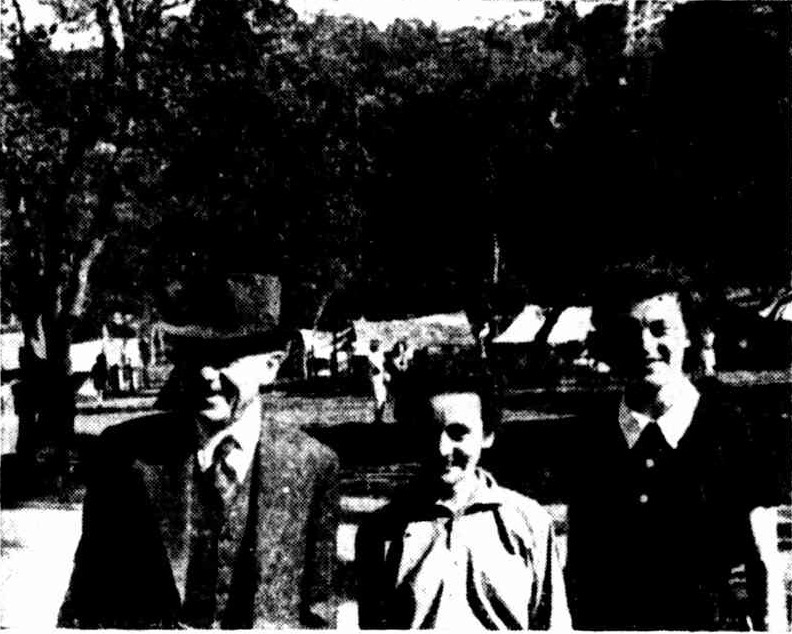
At the National Fitness Camp, Broken Bay, New South Wales. Left to right, Mr. G. V. Brooks (Director of Education), Miss Charlotte Dennis and Mrs. Roger von Bertouch (camp organiser).
AT MEAL TIMES
The biggest consideration in such an undertaking is food. A professional chef cooks all the meals, and they are prepared for cooking and served by roster groups of 12. In the course of the 10 days each girl will have had three turns at roster duty, so no one is overburdened with work. The plan is simple. At meal times the girls form a queue, each one armed with a plate, cup, knife, fork and spoon. They then tile past the service table, take their food to the trestles set out under the trees, and when they have finished they wash their own plates and cups in troughs of hot water set up near the kitchen. On a wet day the tables are set up in the marquee. Their menu includes plenty' of fruit and vegetables and a hot dinner each night. The food is extremely good.
HOT AND COLD WATER
We wash in cold water in the mornings, and most of us get pretty dirty during the day; but it is always possible to get a hot tub in the marquee after supper each night. The daily programme is a Lull one. The rising gong goes at seven, and breakfast is at eight. Between breakfast and the morning assembly at half past nine the girls tidy their tents, and if they wish withdraw money from the "bank" for sweets, ice cream and drinks, and take out library books. Having had no commercial training, I have invented a system of bookkeeping that would probably make a banker whirl round in his grave like a catherine wheel, but it serves the purpose. There is so much clerical work to be done that next time we hope to have a full time clerk on the job.
WORK PERIOD
The tents are inspected and marked by Mrs. Young during the assembly. After the assembly there is a work period. The girls have been divided into six houses -25 in each house- and a house is the unit we use for work and sport. During the work period the various groups clean the lamps, help to rake and level off the basketball and hockey area, tidy up the camp, bring in wood, and put the sports store and tool tent in order. Each group is supervised by an instructor. Then after morning tea, from 11 to 12.30, they go to. sport-basketball, hockey, softball, rowing in the ''whaleboat," volleyball and horse and springboard work on the beach. We change them over every day, so that each house gets a turn at the. six. activities, mentioned above. There is always time for a quick swim before lunch.
MAIL TIME
The ferry comes in with stores, and mail during the sport period, so we are kept pretty busy before lunch sorting and issuing mail and selling sweets in the canteen. After lunch Mrs. von Bertouch takes the whole group for swing exercises and massed folk dancing outside the marquee. We have a piano, so all the exercises and dances are performed to music. The rest of the afternoon is comparatively free, for informal sport or rest.
ENTERTAINMENT
In the evenings we have a show in the marquee. Each house puts on a choir item, sketch and individual items, and for these and their house magazine they receive points. Many of the girls are really talented entertainers and keep the crowd constantly amused throughout the evening. To-night we had a "fancy dress ball" to counteract the effects of our first wet day. We were amazed at the ingenuity some of the youngsters showed. We had everything from a newspaper crinoline-to St. George and an eight-legged dragon. Dick Whittington and his Cat, and Lord and Lady Neptune were particularly good. By the time the parade was' over we were helpless with laughter. I borrowed Luise Rainer's voice and went in Mrs. Young's dressing gown, because the girls had borrowed all my clothes.
PART OF SCHOOL LIFE
Yesterday we all gathered on' the beach to welcome the ferry. On board were Mr. E. J. McKenzie, Mr. Seitz, and Mr. G. V. Brooks (Directors of Education in New South Wales, Victoria and Tasmania), Mr. Gordon Young, Mr. Harold Le Maistre, Mr. Roger von Bertouch, Miss Bocking (headmistress of Burwood School) and Mr. McRorie with his movie camera. The girls put on a special afternoon entertainment for the visitors, who were delighted with what they saw, and in their speeches expressed the hope that this type of camp would become a regular part of school life. From my own experience here I've come to this conclusion that since sunshine and the open air are our national heritage, the least we can do is to see that our young people are. not. robbed of that heritage by cramped .city life. with its commercialised sport and entertainment. In a camp of this kind they live a simple life based on cooperative effort and mutual consideration. They are becoming "fitness conscious" and when they return to their schools they will be the best ambassadors we could wish for for national fitness. They have learned already that they don't have to excel at sport to enjoy it, and, most important of all, they are developing an interest in wholesome pleasures that will stand Australia in good stead when they reach maturity.
END OF THE DAY
The spirit of this camp is such that when we've been on our official rounds of the tents and have tucked up our "family" for the night, and are "dead beat" after a long day's work, we can still gather here for a quiet chat before turning in, and say, "Well, they're more than worth it." OF INTEREST TO WOMEN (1941, June 2). Examiner (Launceston, Tas. : 1900 - 1954), p. 6 (LATE NEWS EDITION). Retrieved from http://nla.gov.au/nla.news-article52419250
NATIONAL FITNESS CAMP
More than 400 girls and boys from post-primary schools will spend the spring vacation at the National Fitness camp at Broken Bay, the Department of Education announced yesterday
The-camp will extend from August 22 to September 8. The girls, who will leave Sydney to-morrow afternoon, will spend the first half of the period in camp, and the boys the remainder. The programme will include camp training, sport, hiking, and genera' physical activities under expert supervisors.
The Minister for Education, Mr. Evatt, said yesterday that physical training would greatly benefit the campers. NATIONAL FITNESS CAMP (1941, August 20). The Sydney Morning Herald (NSW : 1842 - 1954), p. 8. Retrieved from http://nla.gov.au/nla.news-article17743825
SCHOOLGIRLS ATTEND FITNESS CAMP
SYDNEY, Thursday.— An eight-day camp for 200 schoolgirls opened at the national fitness camp at Broken Bay today. The director is Mrs. Roger von Bertouch, wife of the State organiser of Physical Education in Tasmania, who is taking the diploma course in physical education at Sydney University. Mrs. Gordon Young is camp matron and Miss Jean McKenzie roster organiser. The camp is divided Into 'houses.' a number of tents to each 'house' and 'house captains' are appointed. Inter-house competition will be a feature of the camp. SCHOOLGIRLS ATTEND FITNESS CAMP (1941, August 21). The Newcastle Sun (NSW : 1918 - 1954), p. 3. Retrieved from http://nla.gov.au/nla.news-article167488357
FITNESS CAMP OPENED
Premier Sets Stone
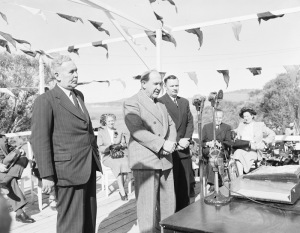 The Premier, Mr. McKell, set the commemoration stone at the National Fitness Camp at Broken Bay on Saturday at the opening of the camp and of huts built by the Rotary Club to accommodate 200 children.
The Premier, Mr. McKell, set the commemoration stone at the National Fitness Camp at Broken Bay on Saturday at the opening of the camp and of huts built by the Rotary Club to accommodate 200 children.
Mr. McKell said the organisation gave youth a chance to make a better world. He paid tribute to the Rotary movement for Its support and to Mr. Gordon Young, the Director of Physical Education, tor his contribution as leader of the movement, of which the camp was one of the concrete achievements. .
There were several bundled visitors at the camp, including the Federal Minister for Health, Sir Frederick Stewart, the Minister for Education. Mr. Evatt, the president of the Victorian Fitness Council, Sir Norman Brookes, one of the Commonwealth Fitness Council members. Mrs. I. Weber, M.L.A., of Victoria, and Mr. Charles Moore, president of the Rotary Club.
Mr. A. E. Symons, chairman of the National Fitness Council, said that the camp would develop two essentials of democracy-community service and leadership-as well as health and fitness.
Sir Frederick Stewart said he hoped that after the war many military camps would be used to develop the movement.
The Government gave £10,000 to develop the camp, and when it is complete there will be a Jetty, refrigeration, kitchens, dining and assembly hall, showers, and a water and sewer-age system. It will be the first of a chain of camps on the coastal area The second site at Wollstonecraft Point, Lake Macquarie, has already been acquired.
(Picture on Page 8.)
NATIONAL FITNESS CAMP OFFICIALLY OPENED
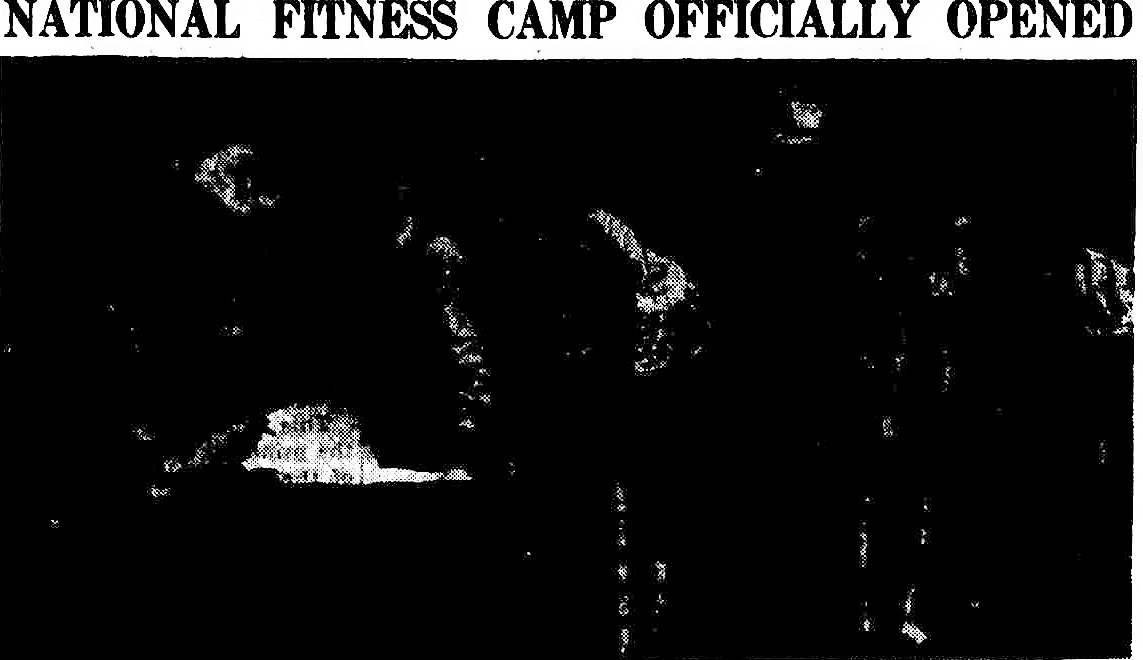
.jpg?timestamp=1624665751447)
The National Fitness Council camp at Broken Bay was officially opened by the Premier, Mr McKell, on Saturday, when members of the Rotary Club also visited the camp. The top picture shows boys of the camp lining up before Miss J. McKenzie, their banker, to receive cash vouchers for the canteen. Lower: Partly completed huts which when finished will house 200 children. The huts have been provided by the Rotary Club. FITNESS CAMP OPENED (1941, September 1). The Sydney Morning Herald (NSW : 1842 - 1954), p. 6. Retrieved from http://nla.gov.au/nla.news-article17763764
FIRST FITNESS CAMP New Deal for Youth
GOSFORD, Sunday. - The foundation tablet of the first national fitness camp of its kind in Australia was laid by the Premier (Mr. McKell) at Broken Bay on Saturday. Similar camps are to be established in New South Wales and other States. The Federal Government, it was stated, had made available £100,000 to the States for the promotion of national fitness. The New South Wales share was £3500 a year for five years. The Premier said that this physical fitness movement was going to be of immense benefit to the Commonwealth.
While the camps would primarily benefit youth, it would be a refuge for tired business men. The President of the National Fitness Council of New South Wales (Mr. A. E. Symons) said that this fitness campaign would spread over the social life of Australia. The National Fitness Council stood for a new deal for the youth of tomorrow.
For the Broken Bay camp the State had made available 400 acres. Sydney Rotary Club had given £2000 for the construction of huts. There would be a jetty, water supply, assembly hall, and administrative units. At present 30 high schools were represented in camp. The success of the movement was assured. Young men and women would be trained in fitness and leadership. School children could spend their vacations in ideal surroundings. The Minister for Education (Mr. Evatt) said that before long there would be a number of similar camps in other parts of the State. FIRST FITNESS CAMP (1941, September 1). Newcastle Morning Herald and Miners' Advocate (NSW : 1876 - 1954), p. 2. Retrieved from http://nla.gov.au/nla.news-article134075946
In 1943 – at Mona Vale in the old La Corniche, The Oaks, building and surrounds another Fitness Camp was established for a little while prior to this being used as an Air League training camp, just alike that established at Avalon Beach in what we today call Ruskin Rowe:
National Fitness Camp
A WEEK'S HOLIDAY at the national fitness camp at Mona Vale to begin to-morrow, will be attended by 100 boys from all parts of the State. Many of the boys have never seen the sea. Professional swimming instructors will attend. CURRENT TOPICS (1943, April 8). Newcastle Morning Herald and Miners' Advocate (NSW : 1876 - 1954), p. 2. Retrieved from http://nla.gov.au/nla.news-article140455420
NATIONAL FITNESS CAMP ENDS
After spending a fortnight in the National Fitness camp at Mona Vale, boys from Wagga and Junee will return to their homes by the Riverina express this afternoon. It was originally intended that the boys would not leave Riverina until the mail train tonight but owing to the heavy holiday traffic the necessary seating accommodation could not be arranged on that train and the boys will now leave Sydney this morning. They will be accompanied on the trip by Mr; E. H. Graham, M.L.A., who has taken a keen interest in the boys during the whole time they have been in camp. The camp, which Is situated near Manly, was arranged under the auspices of the Department of Education. NATIONAL FITNESS CAMP ENDS (1943, April 22). Daily Advertiser (Wagga Wagga, NSW : 1911 - 1954), p. 2. Retrieved from http://nla.gov.au/nla.news-article144121056
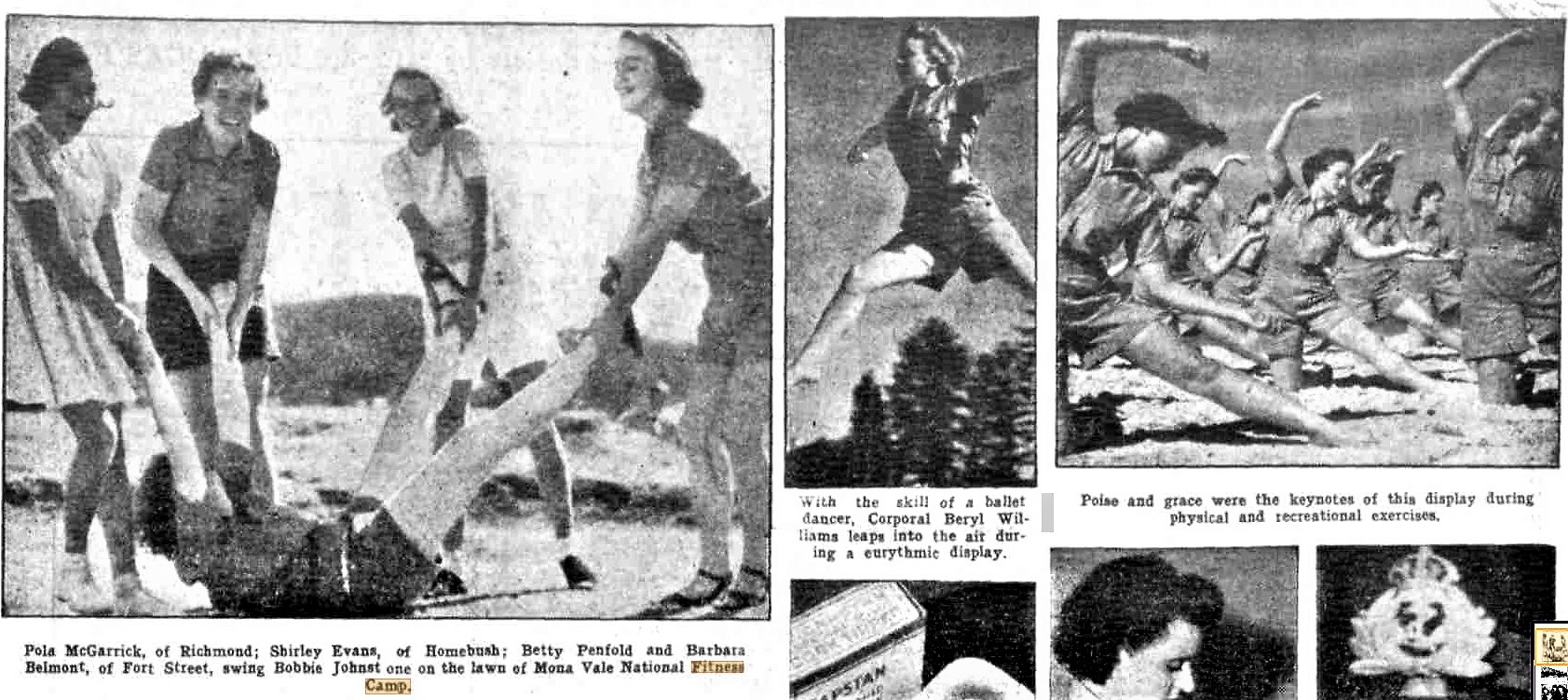
Pola McGarrick, of Richmond; Shirley Evans, of Homebush; Betty Penfold and Barbara Belmont, of Fort Street, swing Bobbie Johnstone on the lawn of Mona Vale National Fitness Camp. With the skill of a ballet dancer, Corporal Beryl Williams leaps into the air during a eurythmic display. Poise and grace were the keynotes of this display daring physical and recreational exercises.
.jpg?timestamp=1624671996528)
"Cooee, here's your mail," calls Miss Alex Ames, Narrabeen postwoman. She resumed her round, despite a sprained ankle, with Pat Johnson, 10, to do the walking. No title (1943, May 27). The Central Queensland Herald (Rockhampton, Qld. : 1930 - 1956), p. 7. Retrieved from http://nla.gov.au/nla.news-article76115715
The Air League boys and girls did not displace those who were booked for a Fitness camp closer to Sydney as that at Narrabeen was established as the grounds at Mona Vale and the adjacent Mona Vale Golf Course were utilised for WWII training:
New camping site for schools
Camping will be part of boys and girls' school curriculum in forthcoming NSW education experiments. Education Minister Evatt announced last night that a new national fitness camp site had been acquired at Narrabeen-Lakes. National Fitness Director Gordon Young said the site was ideal for camping. New camping site for schools (1944, May 14). The Sun (Sydney, NSW : 1910 - 1954), p. 9. Retrieved from http://nla.gov.au/nla.news-article231683857
National Fitness Council.
30th November, 1944.
Ranger, Narrabeen Camp Site. Pay, £4 18s. per week. PUBLIC SERVICE BOARD NOTICES. (1944, November 24). Government Gazette of the State of New South Wales (Sydney, NSW : 1901 - 2001), p. 2041. Retrieved from http://nla.gov.au/nla.news-article225099759
Narrabeen fitness camp on lines of Indian village
THE State Government has taken over about 200 acres of land at Narrabeen for a new National Fitness camp. Education Minister Heffron said last night instructions have been given for construction of a model camp, with all facilities for camping, boating and swimming.
It will be situated on the Middle Creek side of the main lake, near the Cromer golf course and the Wakehurst Highway. National Fitness Director Gordon Young said last night the new Narrabeen camp probably will be built according to the Pueblo design used in the lay-out of Indian villages. It will consist of group cabins for small parties of eight, with a common building for meals and other amenities.
The land adjoining the proposed camp is practically virgin bush and will be ideal for scoutcraft and bushwalking.
The new camp, said Mr. Heffron, will be conducted under open-air school conditions, with children receiving instruction in nature study, hobbies, geology, social studies, plant life, marine growth, camp-craft and bush-walking.
National Fitness camps are already established at Broken Bay and Lake Macquarie.
Mr. Heffron emphasised that camping would be an Integral part of the State's future physical education programme. Work for specialists He said that:— A hundred students are studying physical education as a special subject at the Teachers' College. Thirty specialists are being tunica out each year for work in the schools.
Regional National Fitness officers are operating in the Hunter Valley, Illawarra, Central West, North Coast, Riverina, New England. National Fitness committees have been formed in a large number of important country towns. Arrangements are in hand for next summer's vacation play centres. About 100 centres will be established and thousands of children will take part. Narrabeen fitness camp on lines of Indian village (1947, July 6). The Sun (Sydney, NSW : 1910 - 1954), p. 6. Retrieved from http://nla.gov.au/nla.news-article229701130
Narrabeen was also utilised by many other groups for children's camps along the same lines, as seen in Ella McFadyen's Love Of Pittwater: An Environment, Wildlife and Children's Champion. The academy provided sport and recreation facilities and programs consisting of recreational holiday programs, outdoor educational activities for primary school children and special groups. In 1987 the role of the Fitness Centre expanded into the areas of elite sport and training professional athletes. It is now known as the Sydney Academy of Sport.
By the early 1950s, a revised Physical Education curriculum was introduced. The activities of the Branch expanded, attendance at school camps increased, and the Holger-Neilsen resuscitation method was introduced to many schools. A record number of students attended weekly and vacation swimming classes. The National Fitness and Physical Education Branch was also responsible for establishing vacation play centres during summer vacations at schools, show grounds, sports grounds and recreation halls throughout the state.
The Commonwealth Government provided grants to the Department of Education for the provision of physical education. The grants were administered by the National Fitness and Physical Education Branch and were divided between: training teachers in the theory and practice of physical education, provision of bursaries to enable selected teachers to undertake University courses, development of Health and Physical Education in practising schools and Teachers’ Colleges, production of publications and films, and developing school camping.
By the late 1960s, “the two functions of physical education and national fitness within the Department of Education developed into two almost separate units.''
In 1969 the position of Director of Physical Education and National Fitness was replaced by the new positions of Director of Sport and Recreation and Chief Inspector of Physical Education.” Following this, the National Fitness and Physical Education Branch ceased to exist and separate branches were established. During January 1970, the National Fitness and Recreation Service (Department of Education) was formed.” [16.]
Today the Office of Sport is the lead NSW Government agency for sport and active recreation.
From it's 'About Us' page;
''The Office of Sport aims to increase the levels of physical activity of the people of NSW by providing the leadership, policies, programs, funding and infrastructure necessary to enable higher rates of participation in sport and active recreation.''
''Sport is defined as physical activity that can be undertaken by a team or an individual in a social or competitive environment in pursuit of a result. It can be organised or less formal with a greater focus on social outcomes.
Active recreation is defined as physical activity for the purposes of relaxation, health and wellbeing or enjoyment which can be self-directed or facilitated by a provider or organisation.
Our Mission: Building Active Communities.
Our Vision: Sport and active recreation creating healthier people, connecting communities and making a stronger NSW.''
As seen by the NSW Budget announcements made this week, runs below, encouraging the next generation to 'move it' as a lifelong passion, and for all the benefits it brings, remains a focal point of good governing and building great communities of happy and healthy individuals who can also work together as a great team.
During school days, as well as in later life, people live, not in isolation, but as members of society. Physical Education has as much, if not more, potential than any other subject for developing the group and individual patterns of behaviour which enable people to work and to live happily and effectively in a social setting. The co-educational activities found in a well-integrated Physical Education programme, for example, are social in nature, and, if the teacher is aware of his responsibilities, these can be used to meet the developmental needs of students.
I believe that every Physical Educator has a two-fold task. He has to equip the pupil for his post-school life as well as his school life by educating him to the need for continuing physical education throughout his life. There is more than enough evidence to suggest that the deterioration of thousands of people in middle age is directly due to the lack of physical activity. Although Australians are noted for their love of sport, participation is all too frequently regarded as the prerogative of the young adult, and the older person is relegated to the role of spectator. Frequently, "spectatorism" is due to the fact that a knowledge of golf, tennis, squash, skiing or other active sports has not been acquired during adolescence and the adult is afraid of' making a spectacle of' himself' to begin learning new recreational activities. A Physical Education programme should always make provision for the acquisition of a wide variety of recreational skills. Every child needs wholesome types of recreation which will endure throughout life.
Physical Education is an area within which the child's natural interests, basic abilities and desire for self-expression through activity becomes the means whereby he acquires fitness, establishes emotional stability, develops mental power, learns to make social adjustments and forms an appreciation of, and a desire for, satisfying leisure-time activities. - THE DEVELOPMENT OF THE PHYSICAL EDUCATION CURRICULUM IN THE SCHOOL.S OF NEW SOUTH WALES, by John Alan McLean, B.A., Dip. Phys. Ed. Report submitted to the University of New South Wales in partial tulfilment of the requirements for a pass degree of Master of Education 1976.
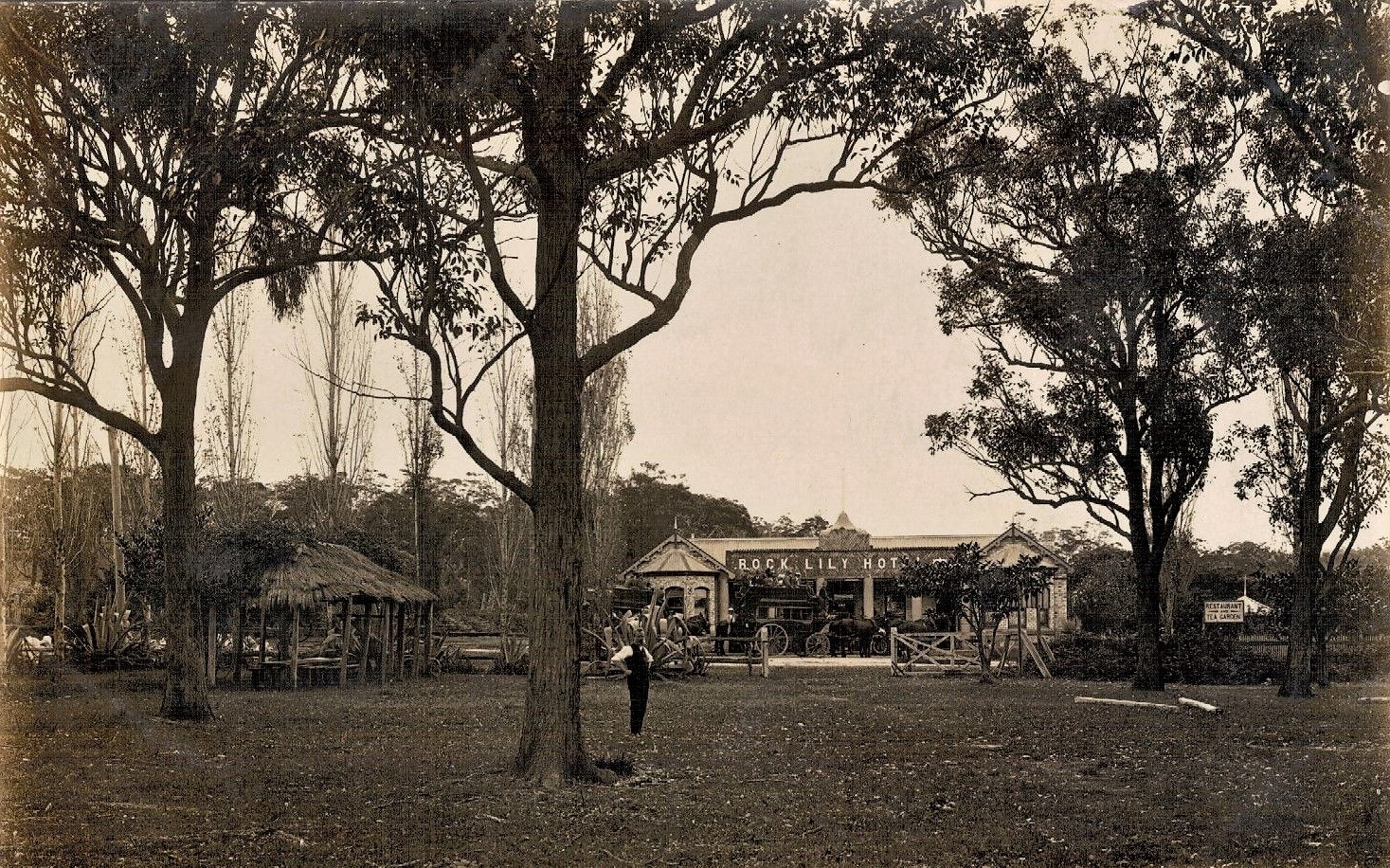
The 'amusement' grounds opposite Rock Lily Hotel - circa 1901-1907
Kids Dive Into Learn To Swim Voucher Program
Multi-Sport Community Facility Fund
Centre Of Excellence Fund
Supporting Our Current And Future Champions
Surf Club Facility Program
References and Extras
- Early Cricket In Pittwater: A Small Insight Into The Noble Game From 1880'S On
- Pittwater Restaurants You Could Stay At The Rock Lily Hotel – Mona Vale
- Taramatta Park, Mona Vale
- Pittwater’s New Cycle Track Of 1901 – Manly To (Newport) Pittwater
- Church Point And Bayview: A Pittwater Public School Set On The Estuary 1880 To 2016
- The NSW Women's Legal Status Bill 1918: How The 'Petticoat Interference In Government' Came Of Age - A 100 Years Celebration Of Women Alike Our Own Maybanke Selfe-Wolstenholme-Anderson
- Avalon Beach Golf Links: Pittwater Fields of Dreams II
- Avalon's Village Green: Avalon Park Becomes Dunbar Park - Some History + Toongari Reserve and Catalpa Reserve
- Pittwater Roads II: Where The Streets Have Your Name - Avalon Beach
- Report of the Minister of Public Instruction for the year 1937 Parliamentary Papers 1938-39-40, Vol.1, pp1150-1151.
- Report of the Minister of Public Instruction for the year 1939, Parliamentary Papers 1940-41, Vol.1, p141.
- Concise Guide to the State Archives (L-O): National Fitness Council; Young, Gordon (Director of Physical Education), The Administration of Physical Education in New South Wales, Lectures to the Students of the Diploma Course in Physical Education, Sydney Teachers’ College, p1, in papers relating to the History of the Department of Sport and Recreation, State Records Accession 4154.
- Report of the Minister of Public Instruction for the year 1939 Parliamentary Papers 1940-41, Vol.1, p155.
- TROVE - National Library of Australia
- State Library of NSW
- Young, Gordon (Director of Physical Education), The Administration of Physical Education in New South Wales, Lectures to the Students of the Diploma Course in Physical Education, Sydney Teachers’ College, p6 in papers relating to the History of the Department of Sport and Recreation, State Records Accession 4154.
- NSW Government Office of Sport - https://www.sport.nsw.gov.au/
- NSW Government State Archives and Records - https://www.records.nsw.gov.au/
- NSW Primary Schools Sports Association (NSWPSSA) still provides opportunities for primary students to participate in competitive sport at the state level and above. https://app.education.nsw.gov.au/sport/NSWPSSA
- The Australian Air League Camps At Mona Vale Beach In The Old La Corniche Building + The Robey Family Of Manly; 'Always Looking Out For Younger People'
- Pittwater Aviatrixes On The Eve Of The RAAF's 100th: A NSW Women's Week - Women Of Aviation Week Celebration
- Ella McFadyen's Love Of Pittwater: An Environment, Wildlife and Children's Champion
- The Outdoor Living Supplement: Outdoor Recreation in Post-War Sydney 1945 – 1975 by Richard Strauss, BA (Sydney), BA (Hons) (Macquarie), DipEd (University of New England), A thesis submitted in fulfilment of the requirements for the degree of Doctor of Philosophy, Department of History, Macquarie University, January, 2007
- THE DEVELOPMENT OF THE PHYSICAL EDUCATION CURRICULUM IN THE SCHOOL.S OF NEW SOUTH WALES, by John Alan McLean, B.A., Dip. Phys. Ed. Report submitted to the University of New South Wales in partial fulfilment of the requirements for a pass degree of Master of Education 1976.
- George Mulhall First Champion of Australia in Rowing - First Light-Keeper at Barranjuey Headland
- Early Pittwater Paddlers, Oarsmen, Rowers and Scullers: The Green Family
- Early Pittwater Paddlers, Oarsmen, Rowers and Scullers: The Williams Family
- Early Pittwater Paddlers, Oarsmen, Rowers and Scullers: The Fox Family
- Early Pittwater Paddlers, Oarsmen, Rowers and Scullers: The Paddon Family of Clareville
- Historic Insights From The Australian National Maritime Museums 1890 Pitt Water 'Era' Yacht Collection: The Basin Regattas
- The First Pittwater Regatta
- Pittwater Regattas - 1907 and 1908
- Pittwater Regattas - 1921 - The Year that Opened and Closed with a Regatta on Pittwater
- Pittwater Regatta Banishes Depression - 1933
- The 1937 Pittwater Regatta - A Fashionable Affair
The NSW School Sport Unit (SSU) is part of the Arts, Sports and Initiatives, Student Support and Specialist Programs Directorate within the Department of Education. The SSU provides carefully planned, adaptable and enjoyable physical activity experiences for all students in NSW public schools. These programs are encouraged by devoted principals and delivered by highly skilled, motivated teachers who positively shape young people to become engaged in their communities and to lead happy, rewarding lives through a lifelong connection to sport and physical activity. Our vision is to be the benchmark for equitable and inclusive provision of school sport and physical activity initiatives in Australia. This is achieved through delivering six key programs:
- Representative school sport pathway
- School Swimming and Water Safety Program
- NSW Premier's Sporting Challenge
- Disability and participation
- Policy and guidelines
- Teacher professional learning
From: https://app.education.nsw.gov.au/sport/
Sport and training camps at Broken Bay
Retrieved from: https://www.sport.nsw.gov.au/sport-and-recreation-centres/broken-bay/sport-and-training-camps
Just 60 minutes north of Sydney at the mouth of the Hawkesbury River, Broken Bay Sport and Recreation Centre offers sporting clubs and organisations access to quality sporting and training facilities and affordably priced accommodation just outside of Sydney.
The Centre provides a range of facilities and accommodation for school camps, kids’ and youth camps, sporting events, fishing adventures, community groups, music festivals and more. It is nestled on 650 hectares of unspoilt bushland between isolated headlands and the beach, with spectacular views of the iconic Barrenjoey Lighthouse, Lion Island and rugged sandstone cliffs lining the River. Abundant in native wildlife and bushwalking tracks, it hosts the Duke of Edinburgh’s International Award programs.
Facilities
The indoor sports hall at Broken Bay Sport and Recreation Centre is in tip-top condition and ready to play host to a range of sports and team training programs. The large outdoor field has a hybrid football goalpost, suitable for junior and club level teams. All of this is located adjacent to the beautiful sandy shore of the Hawkesbury River where you can enjoy swimming and beach activities.
Sporting facilities at Broken Bay Sport and Recreation Centre:
- Recreation hall with indoor basketball/netball/volleyball court
- Large field with hybrid football post
- 25-metre, 5 lane swimming pool with timing clock, shade sail and amenities block
- Tennis court
- Beach volleyball court
- 600-metre sandy beach with netted swimming area
See the full range of activities and facilities we can offer.
Training on and off the field
Improve team performance and capability with outside-the-box team training and activities. From the heights of the challenge ropes course or abseiling to team initiatives, campfire cooking or archery, our tailored outdoor activity programs can deliver maximum impact in the areas of team building, resilience, trust and strategic thought.
Stay where you train
Ideal for weekend training camps, check out our catered accommodation and facilities and stay where you train to improve your game.
More at: https://www.sport.nsw.gov.au/sport-and-recreation-centres/broken-bay
The NSW Government's Office of Sport has 10 Sport and Recreation Centres in NSW, set in scenic river, beach, bush or alpine locations. From the serene beauty of the Hawkesbury River and Lake Macquarie, to the beachy vibe of Lake Ainsworth, alpine country of Jindabyne and pastoral quiet of Borambola, Lake Burrendong and Lake Keepit, each Centre offers different, specialist programs that take advantage of the unique features of their location and facilities.
Whether you're looking for a catered, outdoor school program with qualified instructors, a facility for your corporate or community event or award-winning multi-purpose halls or world-class, regulated training grounds, there's bound to be a Centre that fits your needs.
NATIONAL FITNESS COUNCIL OF NEW SOUTH WALES.
Appointment of Members.
HIS Excellency the Governor and the Executive Council have now approved of the reconstitution of the State Council of National Fitness for New South Wales as hereinafter mentioned and the appointment thereto of the persons named.
B. J. HEFFRON, Minister for Education.
President—The Honourable Robert James Heffron, M.L.A.
Vice President—John Gordon MeKenzie.
Chairman—John Downes.
Members.
Education Department—Dr. Harold Stanley Wyndham, Noel
Leslie Salmon.
Department of Public Health—Dr. Arthur Edward Maehin, Dr. Alfred John Geoffroy.
Department of Local Government—Vivian Vesey Woodthorpe Williams.
Department of Labour and Industry and Social Services— Harold Lark Harris.
Local Government Association—Joseph Bales, Ronald Thomas Clyde Storey.
Shires Association—Albert Mainerd.
Municipal Council of Sydney—Leopold Justin Cunningham. Camps Committee—Russell Jack Miller Newton.
Youth Hostels Association—Frederick Miller King.
National Youth Association—William James Court.
Women's Organisations—Miss Eleanor Manning,
New South Wales Trades and Labour Council—The Honour
able Robert Arthur King, M.L.C.
Special Interests.
Athletics—Harold George Alderson, M.B.E.
Medicine—Professor Harvey Sutton, O.B.E. Recreation—Miss Ethel Maria Lewis.
Institute of Inspectors of Schools—George Andrew Morrow. New South Wales Teachers' Federation—Malcolm Mackinnon.
Roman Catholic Schools—Right Reverend Monseignor James Meany.
Parents and Citizens' Federation—Clarence Leslie Cotlier.
New South Wales Public Schools Amateur Athletic Association—
Frank McRae Gordon.
Adrian Herbert Curlewis. John Renshaw, M.L.A., Roy Norris.
Director of Physical Education—Gordon .Young (ex-officio). Lecturer in Physical Education, University of Sydney— Ernest Harold Le Maistre (ex-officio).
Council's Representative on Board of Studies in Physical Education—Miss Marjorie Swain (ex-ofiicio). (402) NATIONAL FITNESS COUNCIL OF NEW SOUTH WALES. (1946, September 27). Government Gazette of the State of New South Wales (Sydney, NSW : 1901 - 2001), p. 2219. Retrieved from http://nla.gov.au/nla.news-article224793159
William Gordon Young (1904-1974), physical educationist, was born on June 15th 1904 at Guelph, Ontario, Canada, son of David Young, principal, and later inspector of public schools, and his wife Mary, née Underhill.
Gordon attended the Central School and the Collegiate Institute at Guelph, then the International Young Men's Christian Association College, Springfield, Massachusetts, United States of America (B.P.E., 1927). Back in Canada, he studied arts part time at the University of Western Ontario, London (B.A., 1936), and taught physical education at that university and at the Y.M.C.A. He represented the university in football, swimming, ice hockey, gymnastics and wrestling. On 7 June 1930 he married Ellen Patricia Fletcher. During the 1930s he obtained a pilot's licence and competed in American air races. He was director of physical education at Montreal central Y.M.C.A. from 1936 and sometime president of the Canadian Physical Education Association.
The Youngs lived at Neutral Bay. He enjoyed camping, golf and surfing, and belonged to the Royal Empire (Commonwealth) Society. His greatest success was developing community fitness programmes. A jack of all trades, he led teams of volunteers at weekends, even driving the bulldozer himself, to clear the site.
By 1969 there were ten national fitness camps in the State; over three decades, 700,000 children had had an outdoor experience in the bush. Equally popular were his vacation play and swimming centres, and his learn-to-play and community recreation programmes.
By the 1960s coaching and training camps were held at Narrabeen. Young hoped that the camp would become a national sports centre, but its potential was not realized because he preferred North American games such as softball and basketball, failing to appreciate the importance to Australians of cricket and their traditional football codes. He had introduced softball to schools in 1939 and next year was appointed commissioner for softball in Australia by the Amateur Softball Association of America. His interest was shared by his wife Pat, who was founding president of the New South Wales Women's Softball Association in 1947.
A charismatic and forceful man, Young attracted people to his cause 'with his humour, energy and drive', although he did have some detractors who saw him as ruthless and inflexible. Public servants regarded him with trepidation because of his unorthodox approach: Young never believed in saying 'no', sometimes promising support that he could not deliver or spending money that he did not have. His enthusiasm could lead to reckless behaviour. Dr Jack Cross recalled that, while excavating at Broken Bay, Young went 'wild with explosives—it was miraculous on occasions that he didn't blow himself away'.
For four decades Young was known affectionately as 'Mr Phys.Ed.' and 'Mr Fitness'. In 1969 he retired and was appointed M.B.E. He had suffered a severe heart attack after the 1960 Olympic Games in Rome, but rather than slowing down, he planned a rehabilitation centre for coronary victims. Gordon Young died of ischaemic heart disease on 6 September 1974 at Marrickville and was cremated. His wife survived him; they had no children. - R. I. Cashman, 'Young, William Gordon (1904–1974)', Australian Dictionary of Biography, National Centre of Biography, Australian National University, https://adb.anu.edu.au/biography/young-william-gordon-12090/text21693, published first in hardcopy 2002
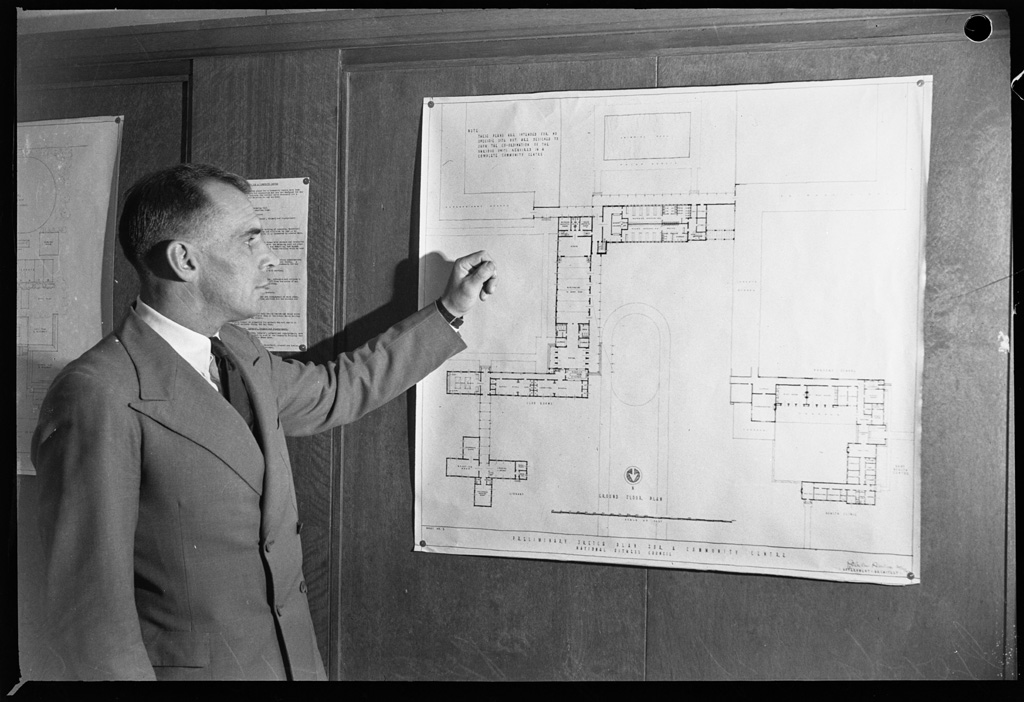
Gordon Young Director physical education - taken for national fitness series, 16 February 1943 / photographed by Alec Iverson, courtesy the State Library of New South Wales.
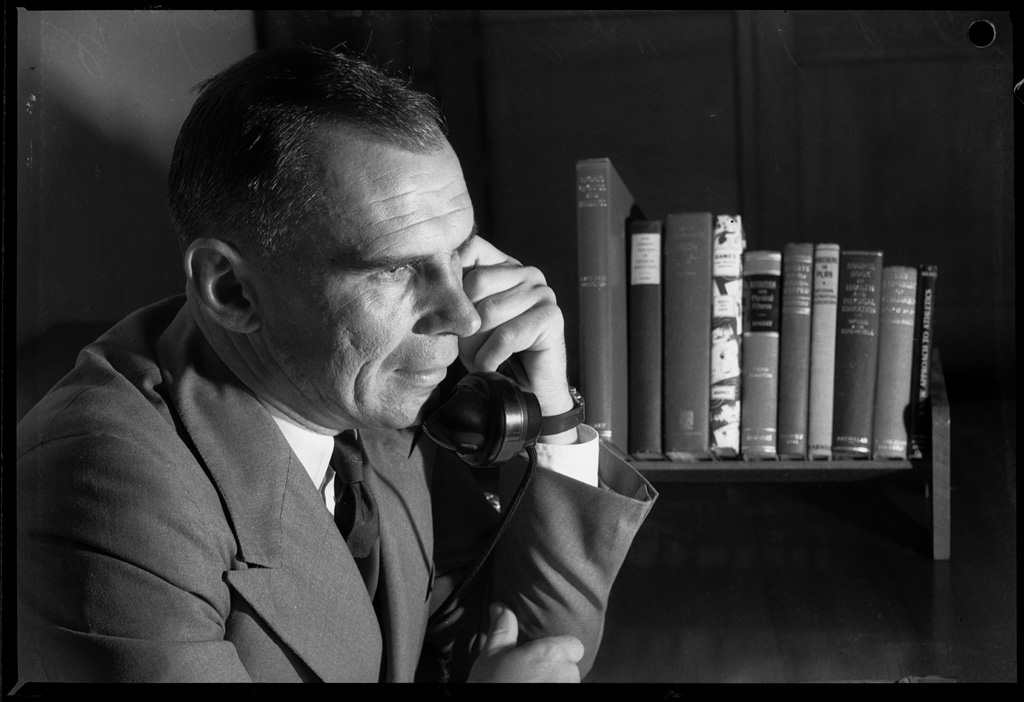
Gordon Young Director physical education - taken for national fitness series, 16 February 1943 / photographed by Alec Iverson, courtesy the State Library of New South Wales.
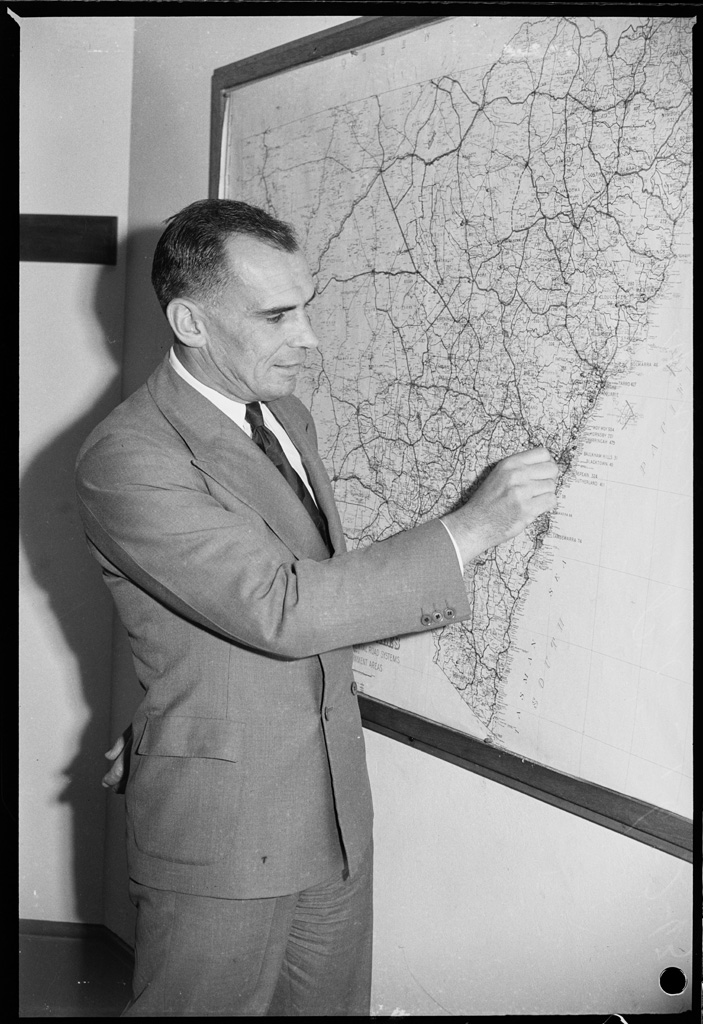
Gordon Young Director physical education - taken for national fitness series, 16 February 1943 / photographed by Alec Iverson, courtesy the State Library of New South Wales.
Committee to See Broken Bay Camp
The visit by members of the Newcastle Committee of the National Fitness Council to Broken Bay fitness camp on Friday will be to see existing buildings and decide on essential improvements for the development of the new camp at Broken Bay.. .The committee wants to get first hand knowledge of the amenities attached -to the camp so that: a good camp will be developed at Myuna, the National Fitness Regional Officer (Mr. S. Delves) said yesterday. Myuna camp, when complete, will be largely used for boys from the Newcastle Fitness Region; and with extensions will also provide facilities for youth organisations .
Broken Bay Camp, known as No. 2 Regional Camp, at present, provides facilities for boys from: the Newcastle: On: arrival at Brooklyn on Friday, the Newcastle party will be met by the Director of National Fitness for New South' Wales (Mr. Gordon Young). He will accompany them on the inspection. Committee to See Broken Bay Camp (1945, June 5). Newcastle Morning Herald and Miners' Advocate (NSW : 1876 - 1954), p. 2. Retrieved from http://nla.gov.au/nla.news-article135003992
'The Broken Bay Quondong'
A very neat and clever little magazine, 'The Broken Bay Quondong,' was put out by pupils of the High School at the boys' National Fitness Camp held at Broken Bay recently. Containing articles on camp life written by the boys themselves, a taking little editorial by Mr. Colin McNab, verse and various other little items, the magazine was a fine production. The lads had an exceptionally good time, as suggested by the 'Quondong.' Mr. McNab's editorial was quite a good one on 'our Silver City,' its High School and different assets of the city. Members of the staff at the camp were: A. H. Walker (Skip), the Camp Director; Mrs. A. H. Walker (Handicrafts, voluntary): J. O'Donnell ('Serge'), H. Ritch ('Snap'), A. Bricknell ('Tarzan'), . G. Miller ('Geoff'). The above were all the permanent camp staff. Also there was Miss A. Pickard, Medical Sister,
Staff who travelled with the boys were W. Johns ('Chips'), J. McHugh ('Fish'), C. McNab ('Uncle Col') and X. Newham. One of the best articles in the maga-xlne w&s* 'Our Appreciation' by Jack Magor and Bryant Turnbers on behalf of the boys. It went: 'On behalf of the boys of Broken Hill High School who joined in our crusades at Broken Bay, we wish to extend our sincerest thanks to the* following people who made our- trip possible. 'To Mr. Perkins whose Interest and enthusiasm 'for this new educational venture was so evident when he so whole-heartedly gave us every encouragement to participate In this grand trip.. ; . ^ 'To Uncle Col, Fish and Chips, who did all in their power to make the trip both comfortable and Interesting, and our stay In the camp enjoyable and
'To Skip and his staff, who so capably attended to our every need in the way of activities and instruction. We congratulate them on having built up a grand scheme and one that we recommend to every boy. 'To Snap, who readily gave up part ot his leave to Journey to the Hill to help organise and escort our number to camp.
'To Mr. Sands, Fred, Jim and Bert, who were our Ministers for Interiors. Then last, though not least, to Sister, Who willingly and wisely, attended to those who needed her assistance. Once again, to all concerned, our heart-felt thanks.' ; Articles In the magazine included 'A Trip to Patonga,' by Ian Rogers, 'To Spring Beach ' by Ray Whitburn and John Kelly, 'The Horseshoe Trail,' by L. Thomas and B. Davis. 'The Trip To Rocky Ponds' by A. Callaghan and L. Schultz, and 'A Great Day Out' by J. Baillie and K. Rodda. 'Uncle Col Goes Fishing' by John Baillie was a well constructed poem. All the Items in the magazine were written from actual camp incidents, the whole production being quite interesting, and bespoke an excellent time by all during their stay at the Broken Bay site. "The Broken Bay Quondong" (1946, October 5). Barrier Daily Truth (Broken Hill, NSW : 1908; 1941 - 1954), p. 3. Retrieved from http://nla.gov.au/nla.news-article141169172
An Interview with Gordon Young
DIRECTOR OF PHYSICAL EDUCATION IN NEW SOUTH WALES
By D.C.H.
Our Editor, in the issue of 'The Methodist' of 8th May, has an enlightening and typically awakening article on 'Juvenile and Other Crime.' Our Editor, as leader of our Church, states facts that are humiliating and startling. Let our Church take heed to his words. So when meeting Gordon Young, Director of Physical Education and Executive Officer of the National Fitness Council of N.S.W., it was too good an opportunity to miss. Enquiring and seeking news of his work, my talk became an interview.
Who is Mr. Young, and what is his work? On first seeing the man one is impressed with his virile physical strength. He reminded me of Snowy Baker But his searching, penetrating eyes give one an idea of a man seeking after some great thing, and surely his ideals, aims and purpose endorse one's impressions If all that is in his heart for the good of all the youth of N.S.W. is accomplished, the name of Gordon Young will go down in Educational History as surely and impressively as those of Henry Parkes and Peter Board. Five years ago our Government brought this man from Canada. As Director of Physical Education he is responsible for the Physical Education of /the children in our State schools. As executive officer of the National Fitness Council the sphere is much wider. The function of the National Fitness Council is to care for the physical welfare of the people from the cradle to the grave. It has a gigantic task, but already much has been accomplished in the way of camps and play centres.
'Do you know,' said Mr. Young, 'there are 400,000 school children up to the age of 18 who need our work? The Churches and other organisations are only touching one tenth of the vast field of youth welfare for its spiritual, moral and physical wellbeing.'
'The National Fitness Council aims to make these children fitter in body, and wider awake mentally,— awake to their responsibilities as citizens of Australia. By bringing boys and girls into our camps they are better socially, educationally and physically. They benefit, and so does the whole nation. To the unprivileged, we aim to give benefits which are their due. Our purpose is to extend the good work which the churches are doing, but doing in a very limited field. We aim to associate the church work with the Government work for the better well-being of the youth of all classes, making no limitation of class or creed.'
'We have already established camps at Broken Bay, Lake Macquarie and Mona Vale. The boys and girls who go to these camps don't just 'rough it' in the bush or at the seaside. The camps are designed to give the boy a change of environment, to train him in fitness of body and alertness of mind by games, exercises, study groups, camp craft, camp, newspapers and leadership. The establishment of a chain of National Fitness Camps will develop our nation. 'In the matter of religion, tell your church people that we have religious services every Sunday for the whole of the camp staff and all the youngsters. The service will be conducted by noted lay preachers, especially men with University training.
'Nor are camps the only activity of the National Fitness Council,' said Mr. Young. 'During the Christmas vacation the National Fitness Council organised 32 Vacation Play Centres. 105,000 children attended these centres. The Play Centres are not just places where children come to be amused. Admittedly the children are free to choose what they shall do, but their choice is directed towards making a wise use of their leisure time. 'The activities of the centre are many and varied. They include craft work of every description. The equipment of the centre includes indoor games, books, sporting and games' equipment for outdoor activities, and included in the programme are other physical activities. '
'Not the least important feature of the Play Centres is the free distribution of milk. Each child receives half a pint daily.'
'The National Fitness Council has just launched the National Youth Association. The object of this Association is to co-ordinate the work of existing Youth Organisations. The Government and the Council are anxious to develop the influence of Youth Organisations because they believe these organisations provide opportunities for personal development and for the practice of virtues in social relationships. In addition, it is pointed out, they combat the influence of bad environment at home or in industry, and help to prevent the development of delinquency.'
Such is the work of the National Fitness Council with Director Gordon Young at the helm. A new day for youth is certainly dawning under this regime; support should be given to it by every section of the community. An Interview with Gordon Young (1943, July 10). The Methodist (Sydney, NSW : 1892 - 1954), p. 3. Retrieved from http://nla.gov.au/nla.news-article155473932
An added bonus for having these camps was the people who permanently were on site to look after them and their clear individual natures to support, care for and further all aspects of Australia herself:
FAUNA PROTECTION ACT, 1948, AND BUSH FIRES ACT, 1949.
Appointment of Honorary Rangers and Honorary Fire Patrol Officers.
THE undermentioned persons have been appointed as Honorary Rangers and Honorary Fire Patrol Officers for the purposes of the abovenamed Acts:—
Mr. Reginald Walter Lumley, Superintendent, Narrabeen Lakes National Fitness Camp, Narrabeen, and Mr. Neville Francis Munns, Warden, Commodore Heights National Fitness Camp, via Broken Bay. (A. 57-2,077 and A. 57-2,078) (9104) C. A. KELLY. FAUNA PROTECTION ACT, 1948, AND BUSH FIRES ACT, 1949. (1957, December 6). Government Gazette of the State of New South Wales (Sydney, NSW : 1901 - 2001), p. 3886. Retrieved from http://nla.gov.au/nla.news-article220359960
WILD FLOWERS AND NATIVE PLANTS PROTECTION ACT, 1927-1945
Appointment of Honorary Rangers
THE undermentioned persons have been appointed as Honorary Rangers for the purposes of this Act:—
Eric Alexander, 13th Avenue, Sawtell; Ernest George Ashton, 28 Westminster-street, Bexley; Henry Abraham Joseph Bagnell, Broken Bay National Fitness Camp, Brooklyn; Alston John Bourne, c.o. Forestry Office, Wauchope; Hilton Cassell Brown, 141 West Head road, Terrey Hills; Neville Geoffrey Burgin, 14a Evans-street, Wollongong; Norman Gregory Clark, 296 Manfred-street, Windale; John Clive Cousins, c.o. Forestry Office, Wauchope; Frederick Robert Craven, 234 Gosford-road, Adamstown; Victor John Douglas, Broken Bay National Fitness Camp, Brooklyn; Cleive Andrew Etchells, 32 Vimiera-road, Eastwood; Leslie Hastings Falle, c.o. Ranger's Office, Bobbin Head; Peter Brian Fischer, 8 Aubrey-road, 'Northbridge; Samuel Foley, 40 Rabaul-road, Georges Hall; John Blaydon Garvey, Broken Bay National Fitness Camp, Brooklyn; Oliver Chapman Glanfield, 203 Raglan-street, Mosman; Desmond Frederick Gray, 17 Blackalls-avenue, Blackalls; Wallace Jackson, c.o. Ranger's Office, Bobbin Head; Albert Hilton Linklater, The Lodge, Chase-road, Mount Colah; George McGregor, 132 Cardiff-road, Wallsend; Frank Owen McManus, 56 Albion-street, Surry Hills; Jack Minto, c.o. Koala Sanctuary, Bobbin Head; Philip Leonard Nixon, 24 Deniston-street, Hornsby; John Michael O'Brien, "Wirroona", Berowra Waters road, Berowra; Frederick Craig Peters, c.o. Koala Sanctuary, Bobbin Head; Gerardus Adriaan Polle, 33 Blaxland-road, Killara; Mavis Isabel Purvines, 23 Bee Farm road, Springwood; Arthur Leonard Randall. Elder-street, Lambton; Sydney Arthur Read, The Basin, via Palm Beach; James Butler Rose, 7 Ian-street, Seven Hills; Donald Peter Sands, 85 Alexandria-parade, Wahroonga; Alice Mary Small, High School, Wellington; Robert Smith, Laurel-avenue, Young Wallsend; James Arthur South, 25 Lime-street, Cabramatta; Lisle Alexander Thomson, Broken Bay National Fitness Camp, Brooklyn; Leslie Joseph Trist, Broken Bay National Fitness Camp, Brooklyn; Kenneth Henry Walkley, No. 2, The Lodge, Ku-ring-gai Chase, Turramurra North; Ernest Amos Charles White, Macquarie-road, Cardiff; Michael George White, c.o. Forestry Office, Wauchope; Colin Thomas Wilson, c.o. Koala Sanctuary, Bobbin Head. (G. 58-113) (164) J. B. RENSHAW, Minister for Local Government. WILD FLOWERS AND NATIVE PLANTS PROTECTION ACT, 1927-1945 (1959, February 13). Government Gazette of the State of New South Wales (Sydney, NSW : 1901 - 2001), p. 429. Retrieved from http://nla.gov.au/nla.news-article220271458
National Fitness Camp Broken Bay, March 1948
Photos courtesy Mitchell Library, State Library of New South Wales